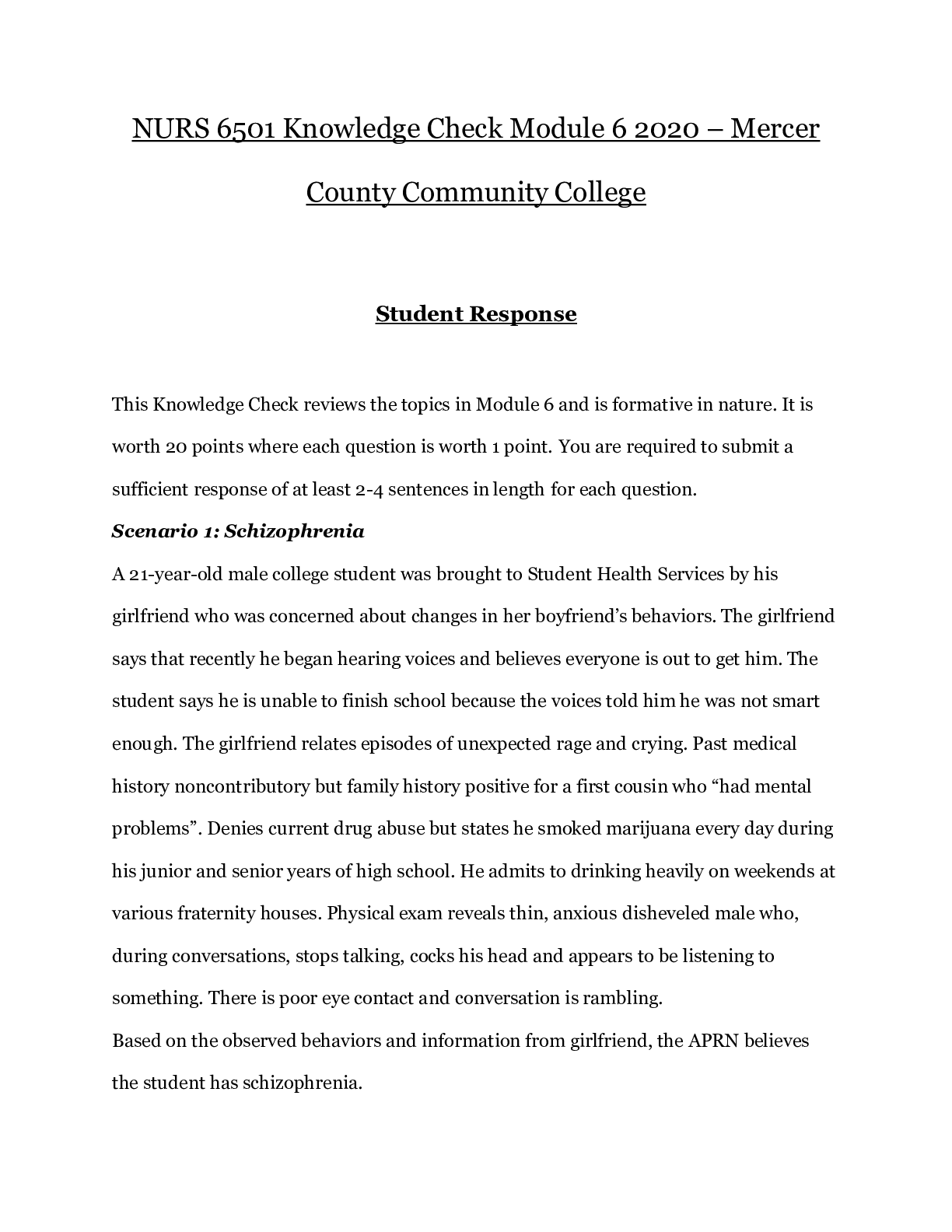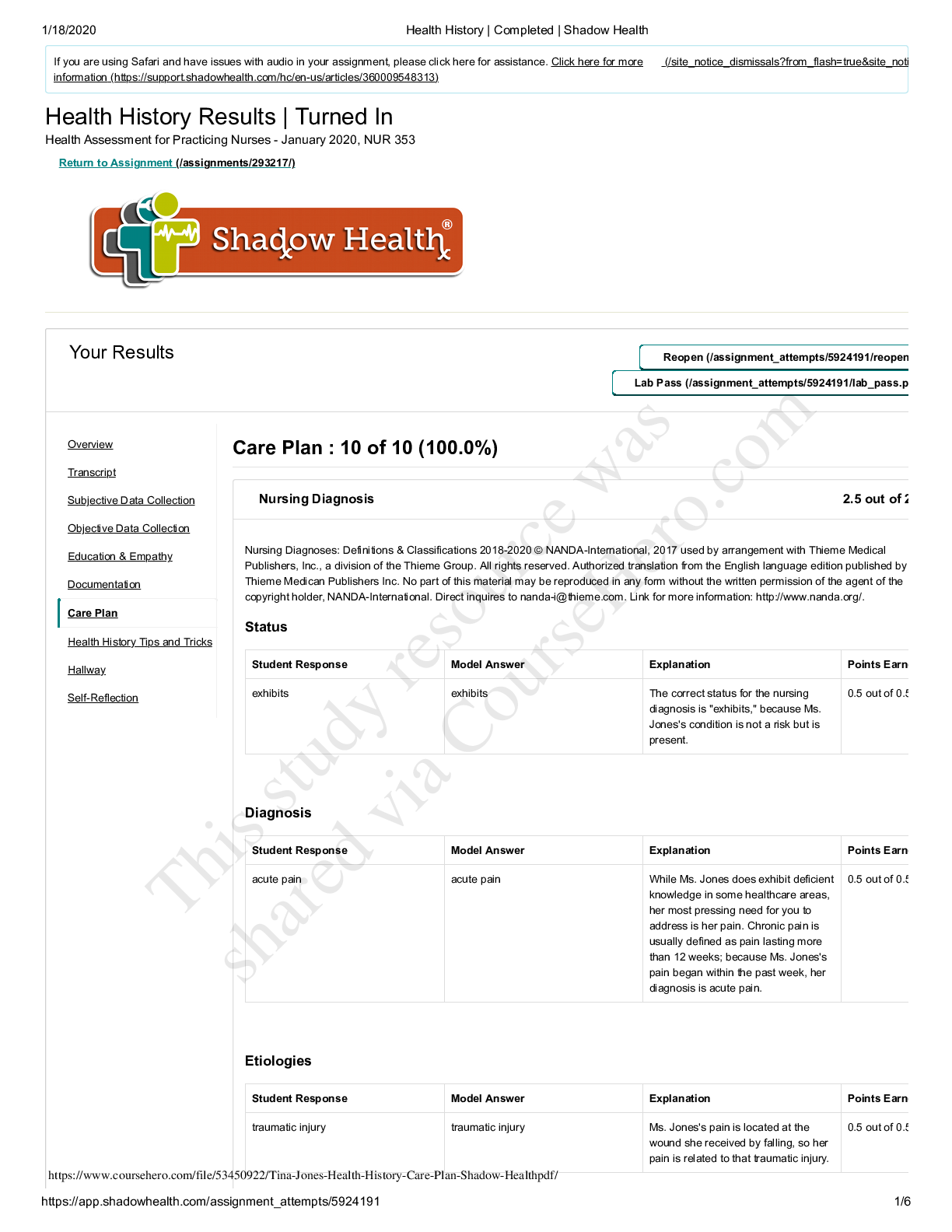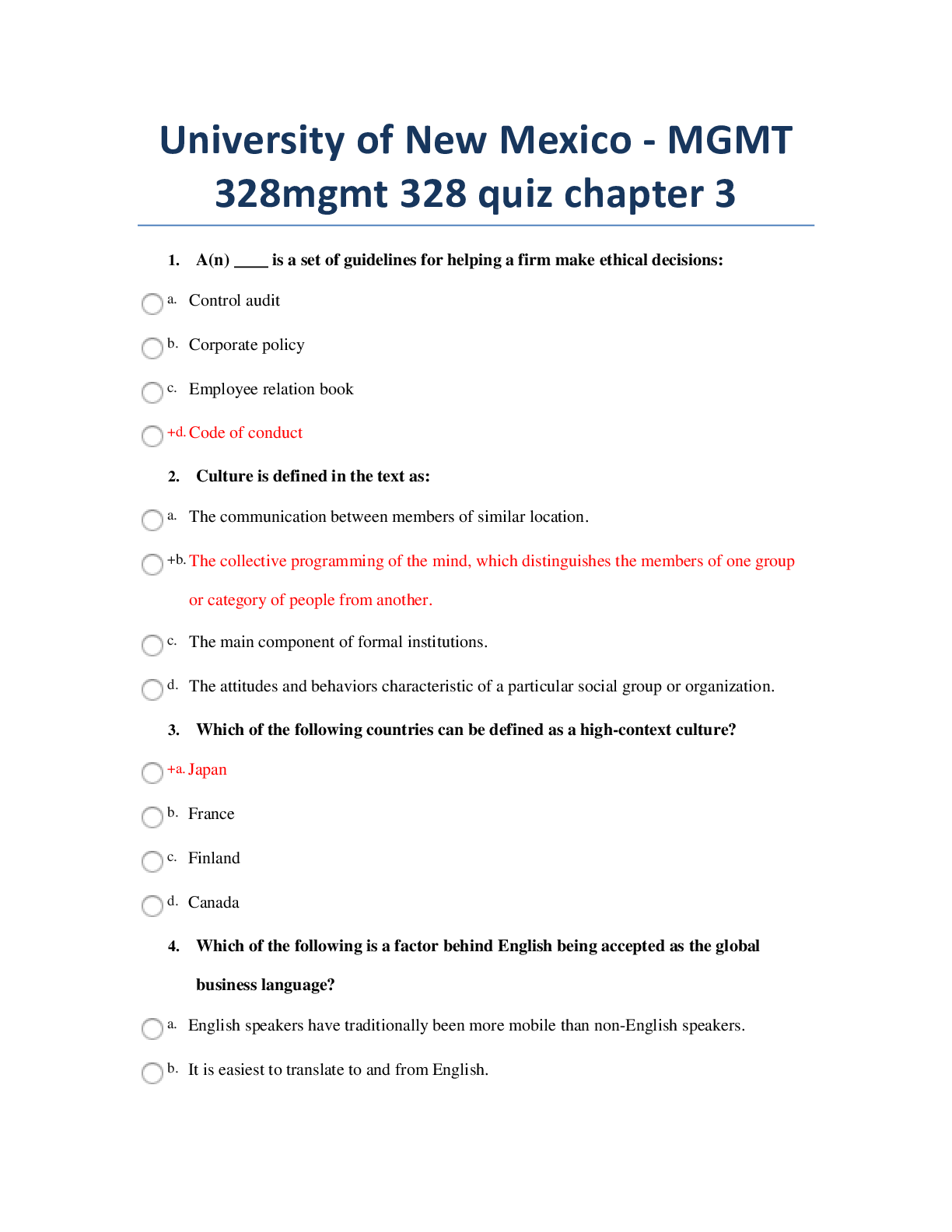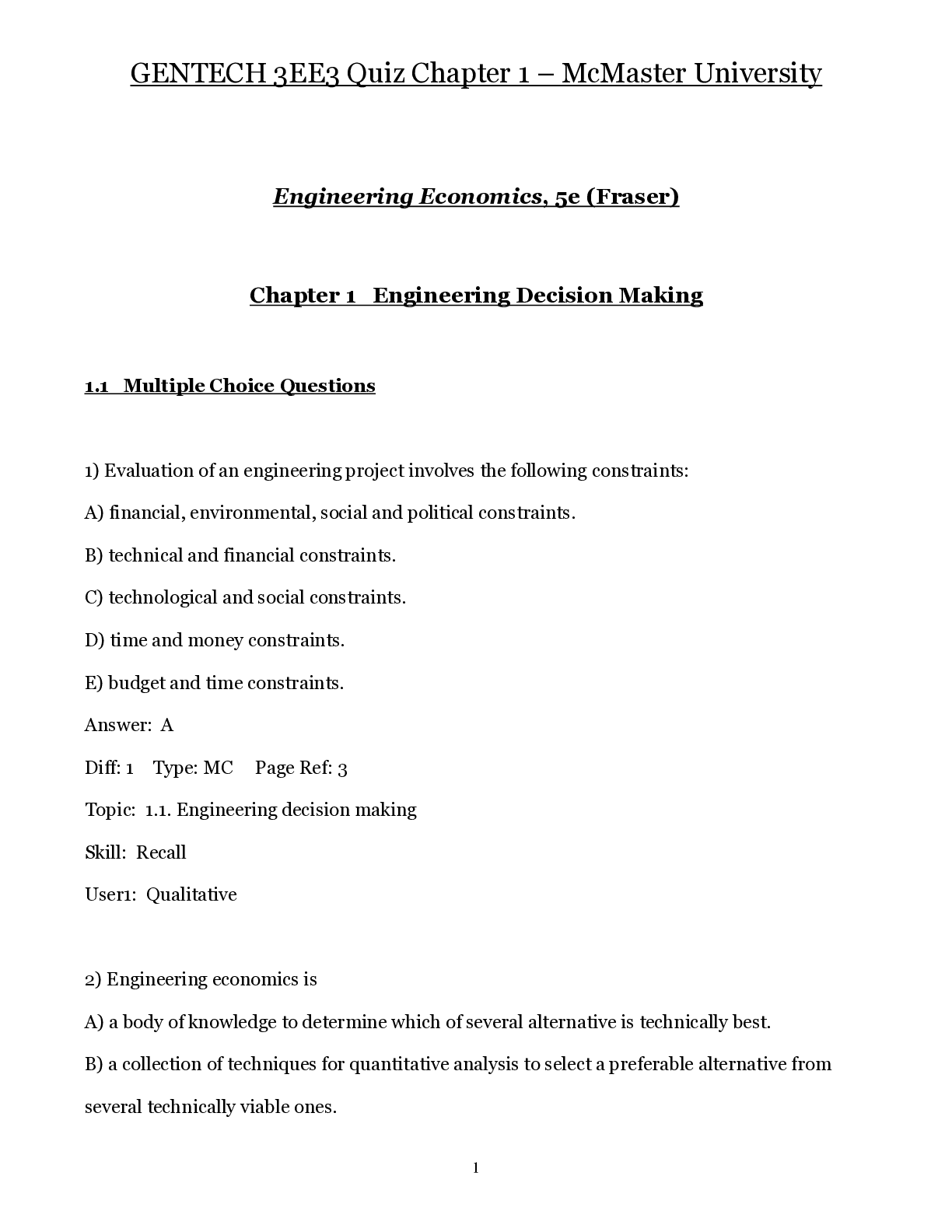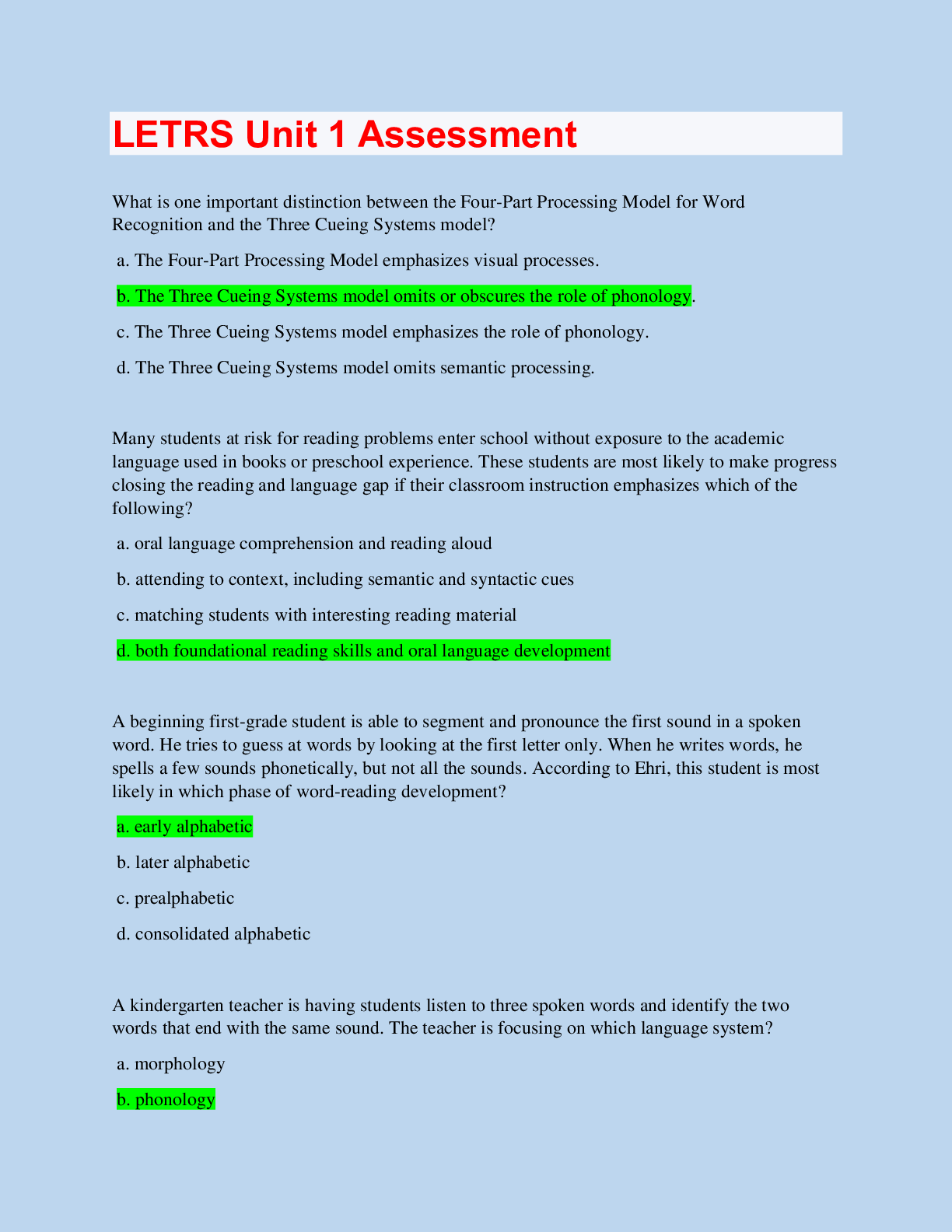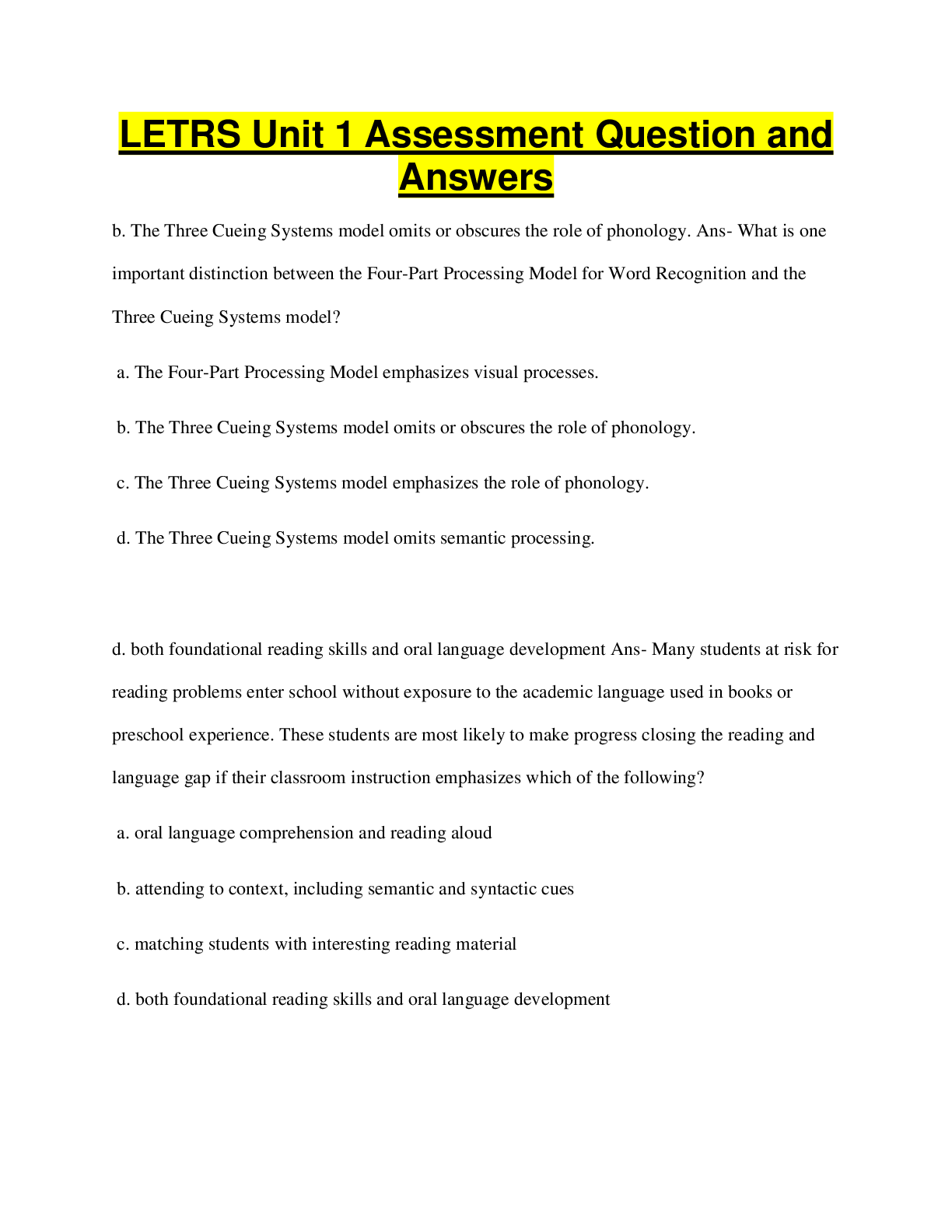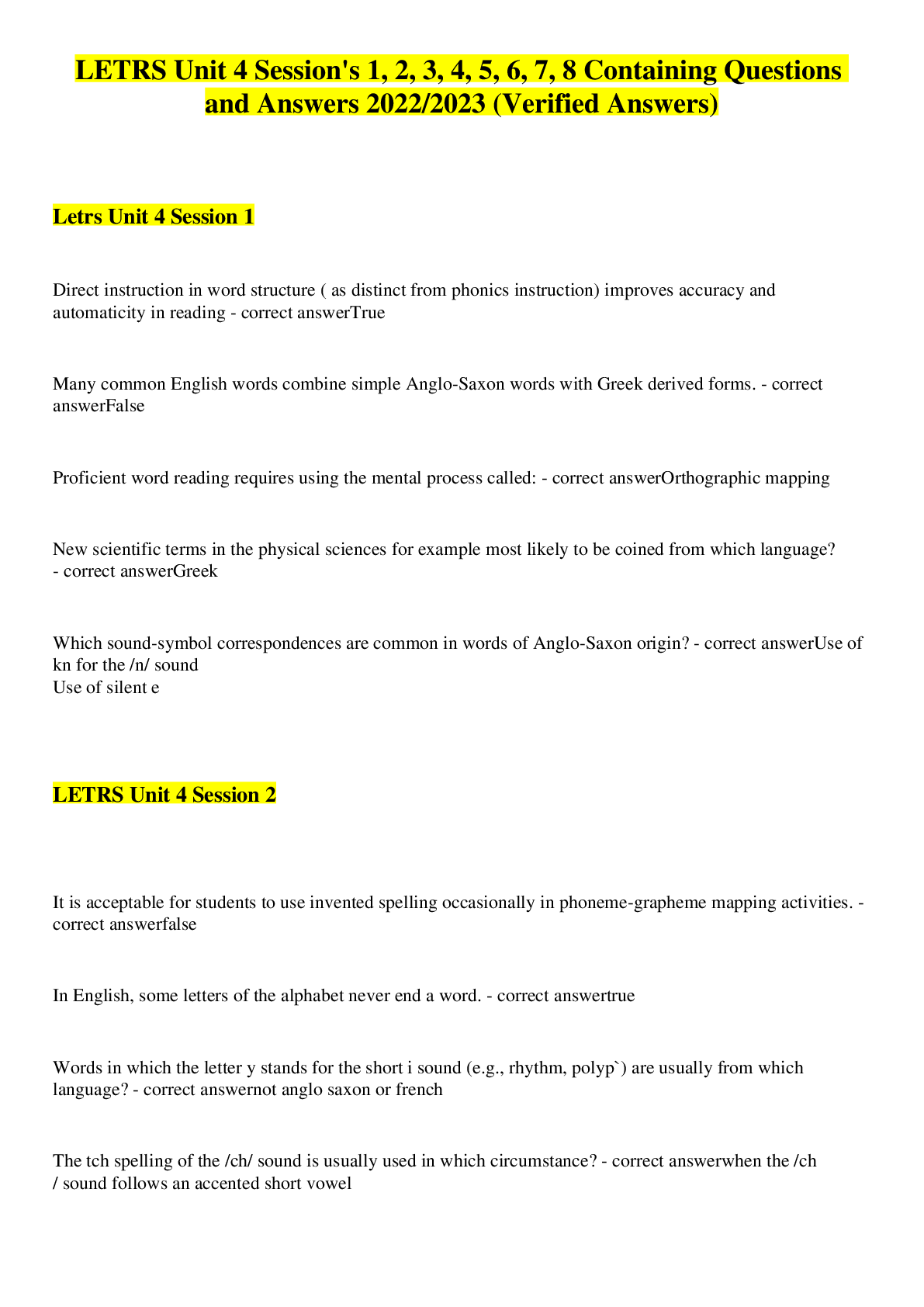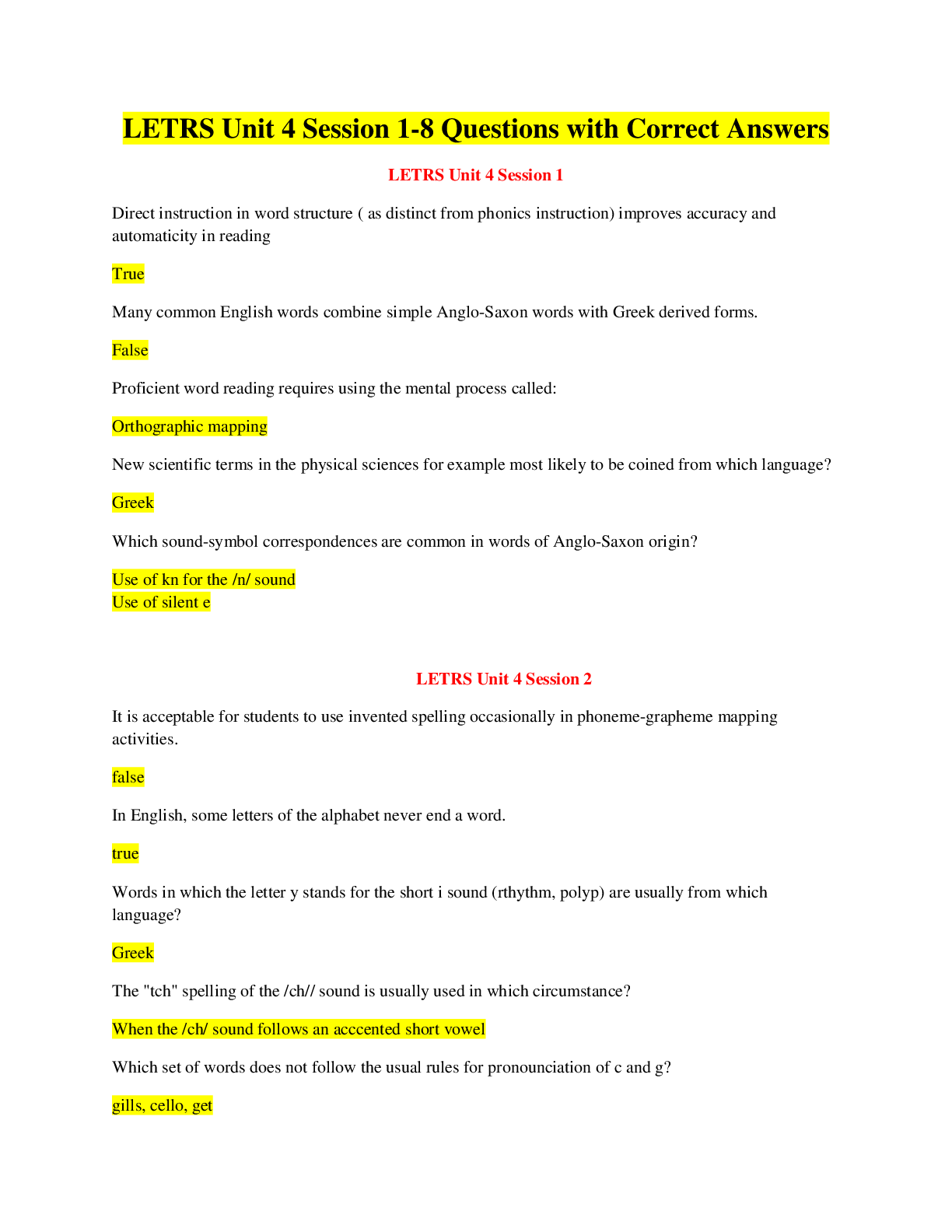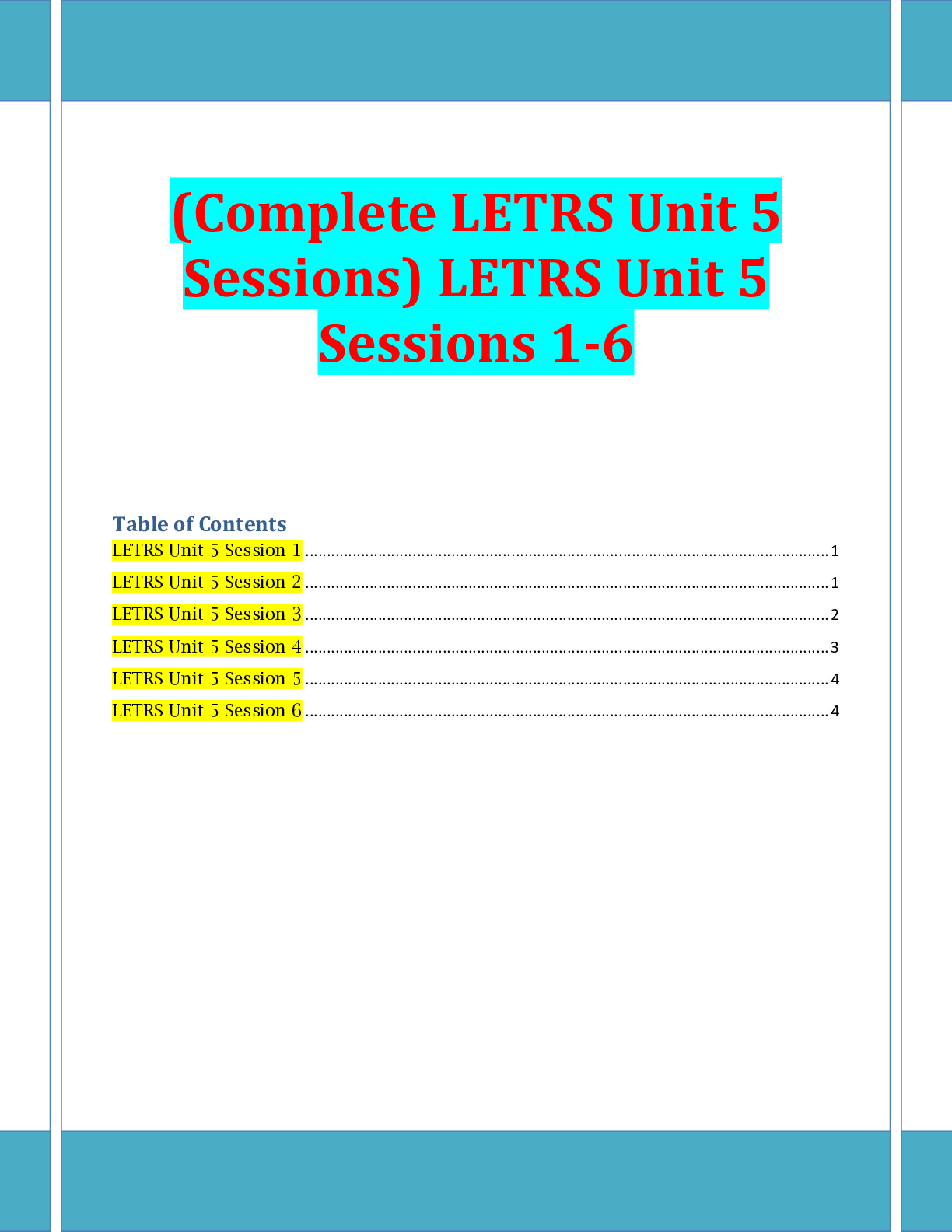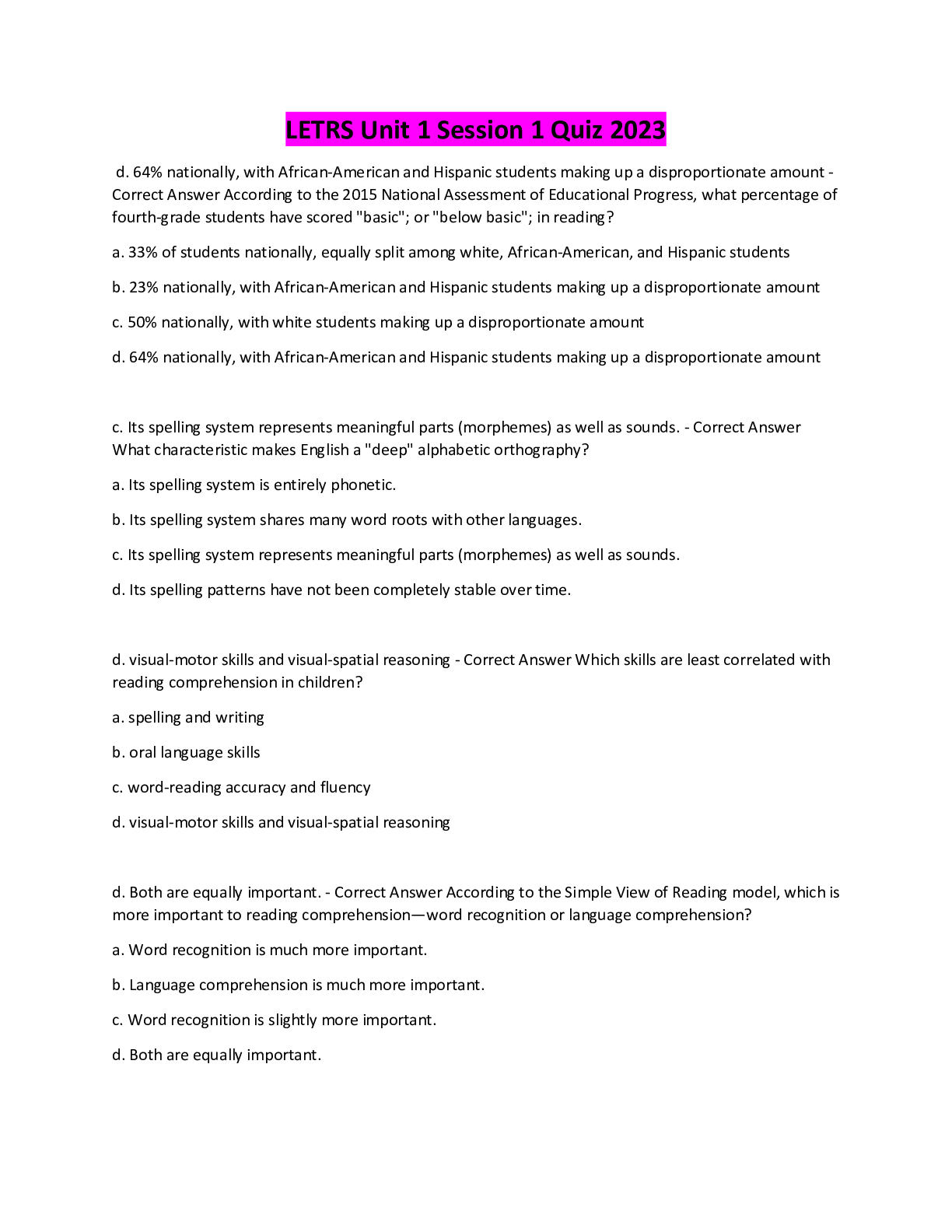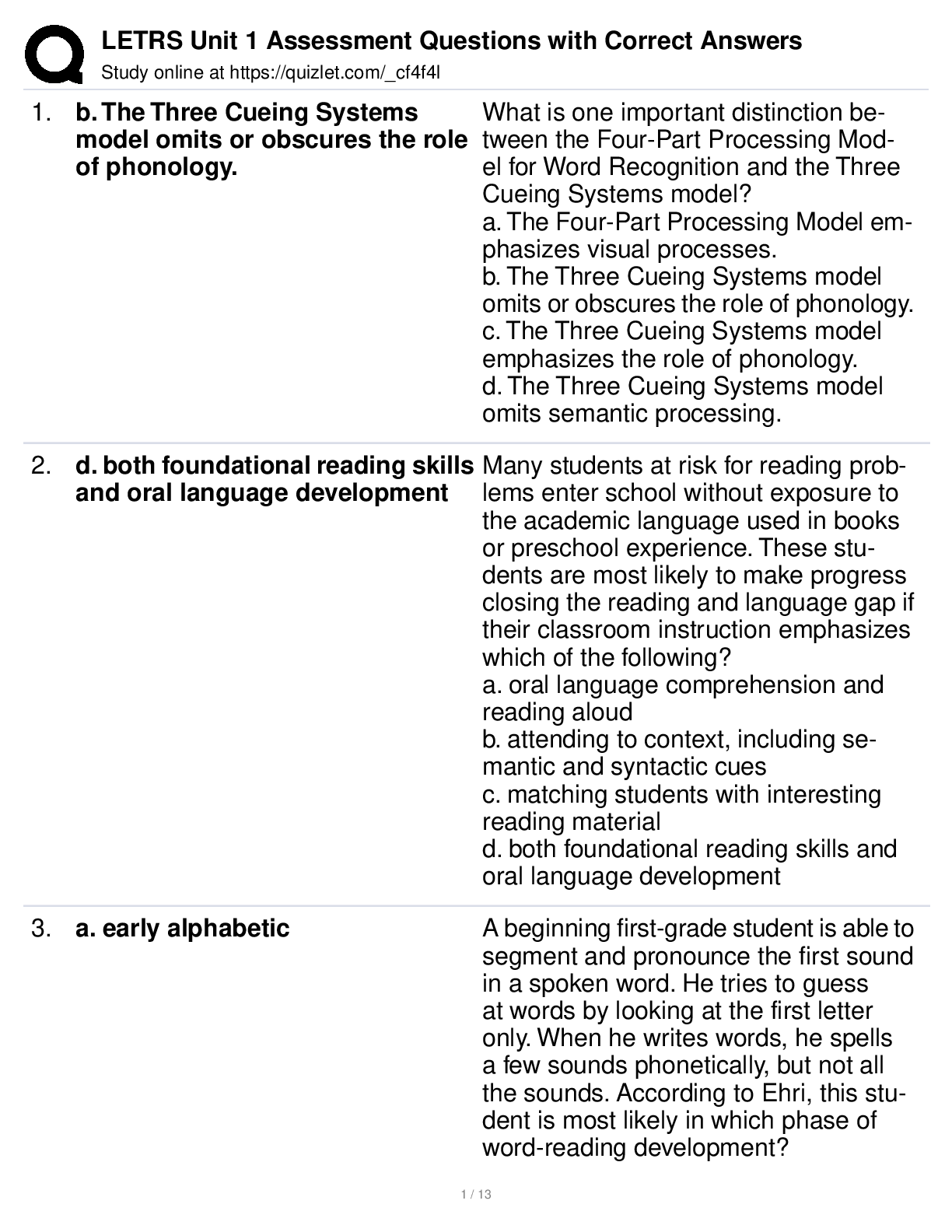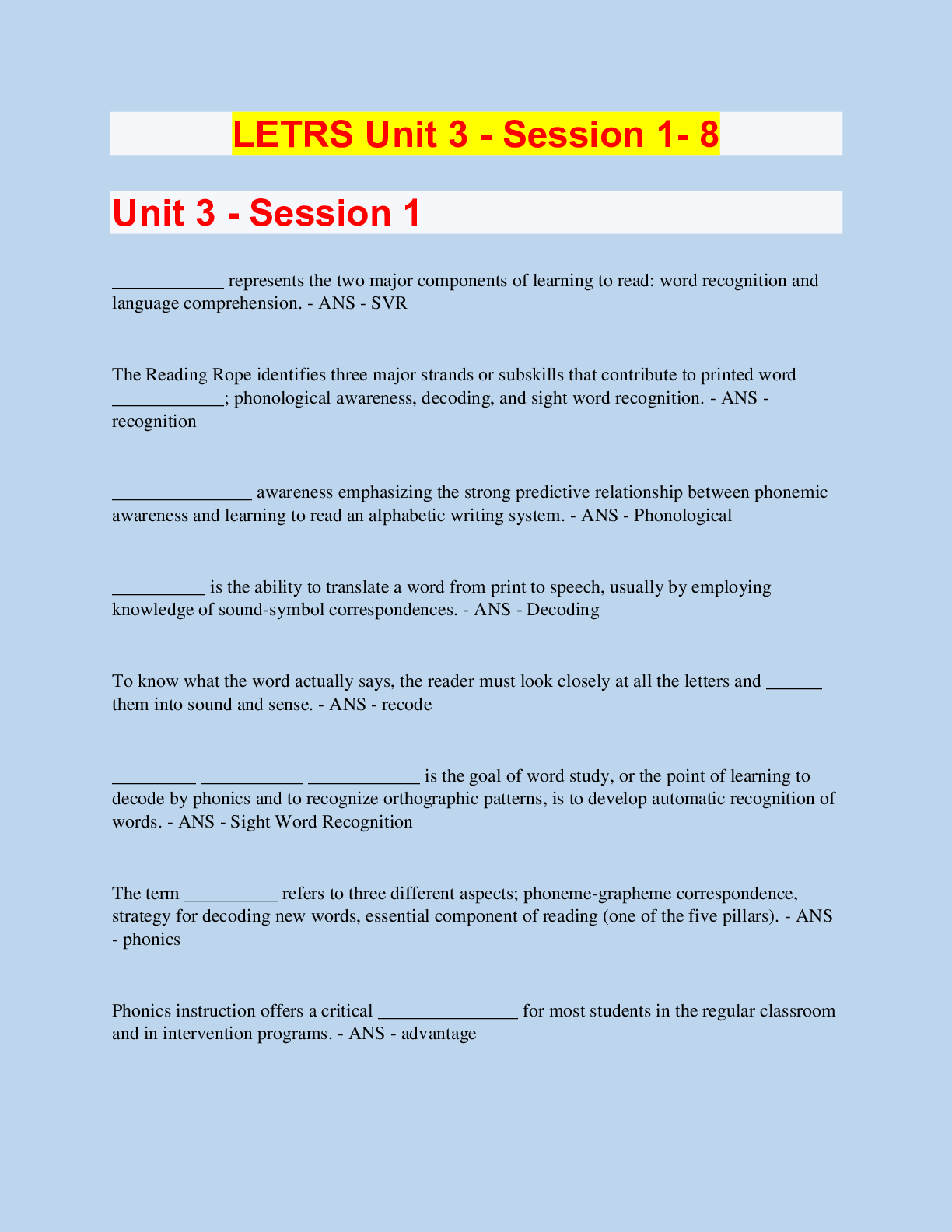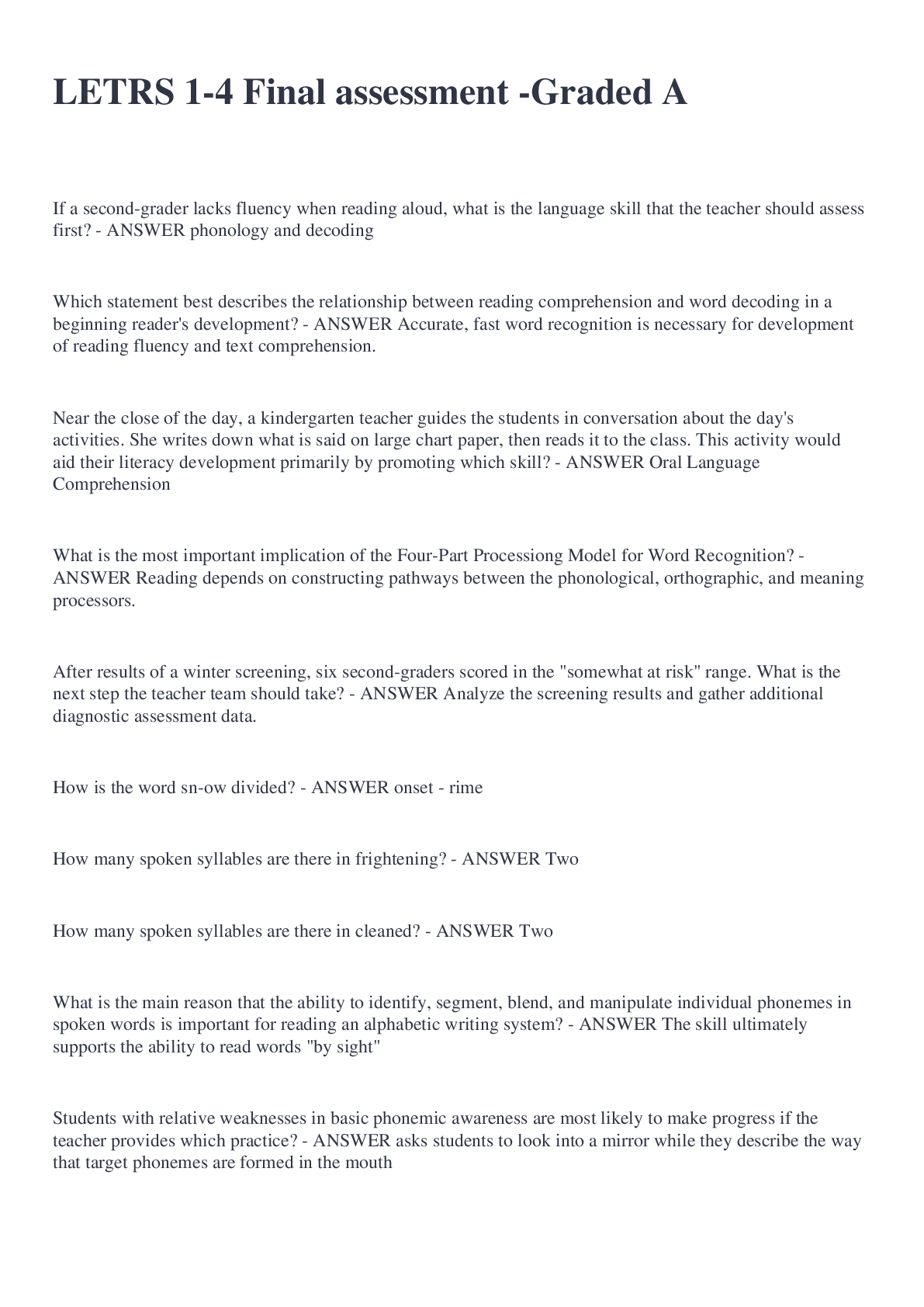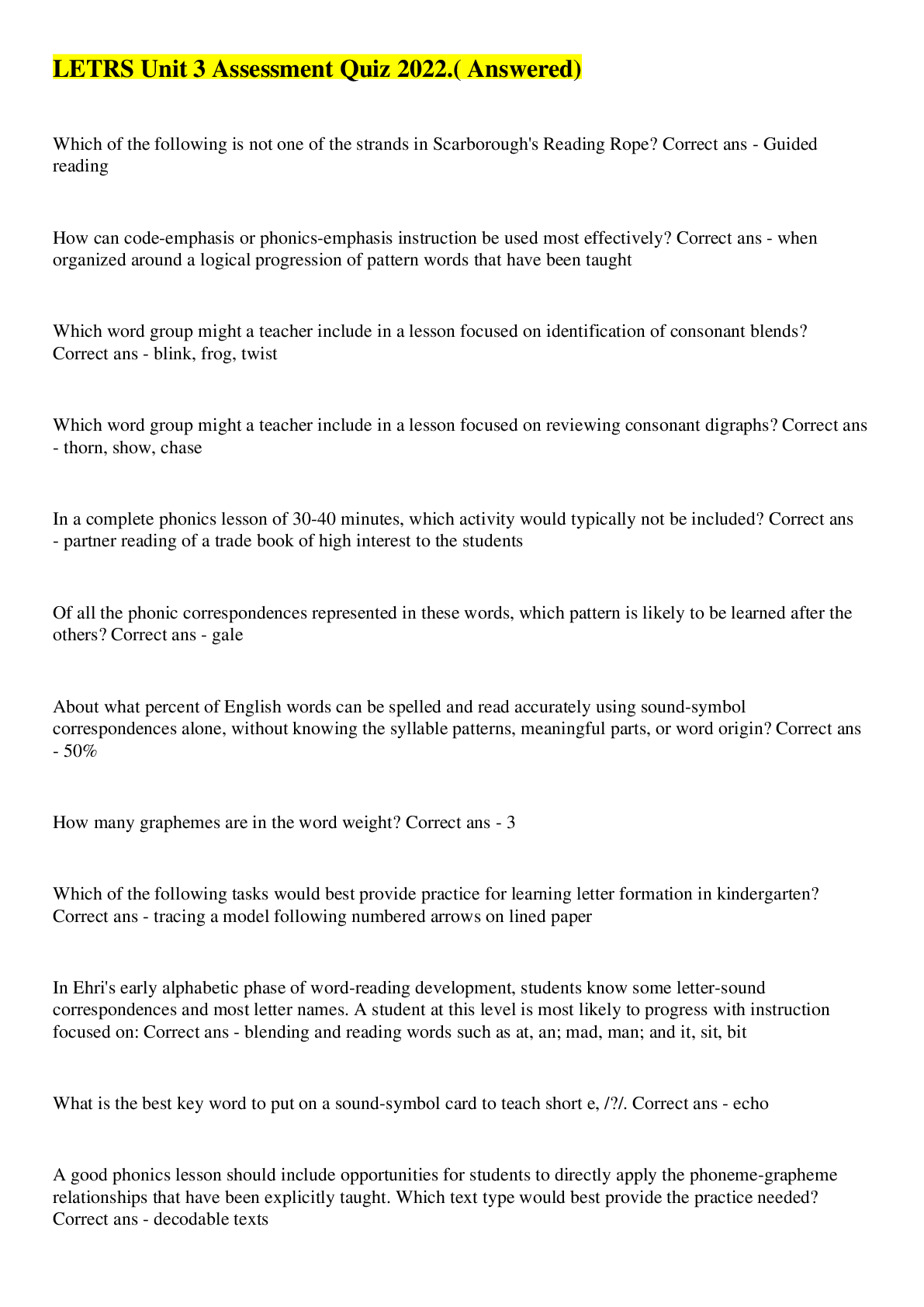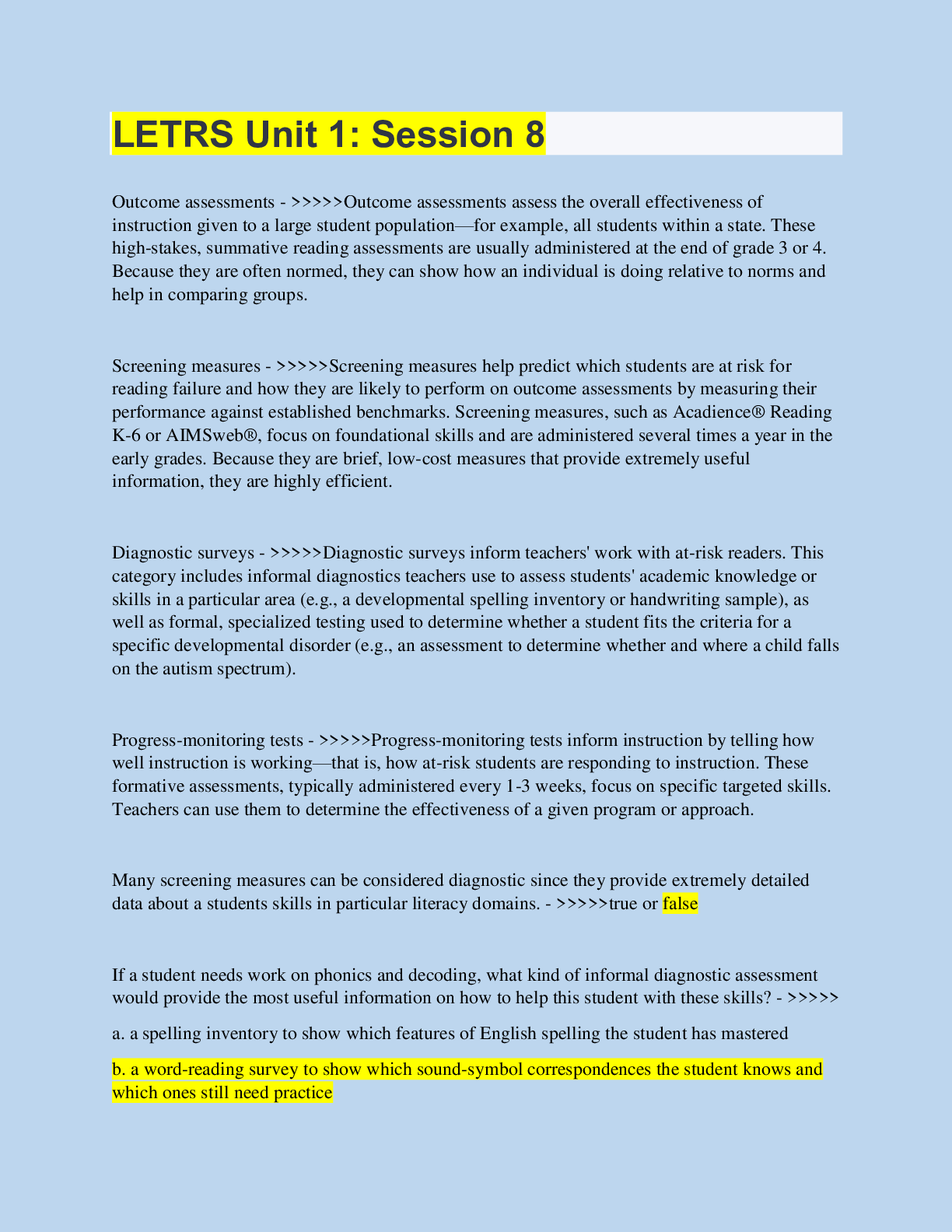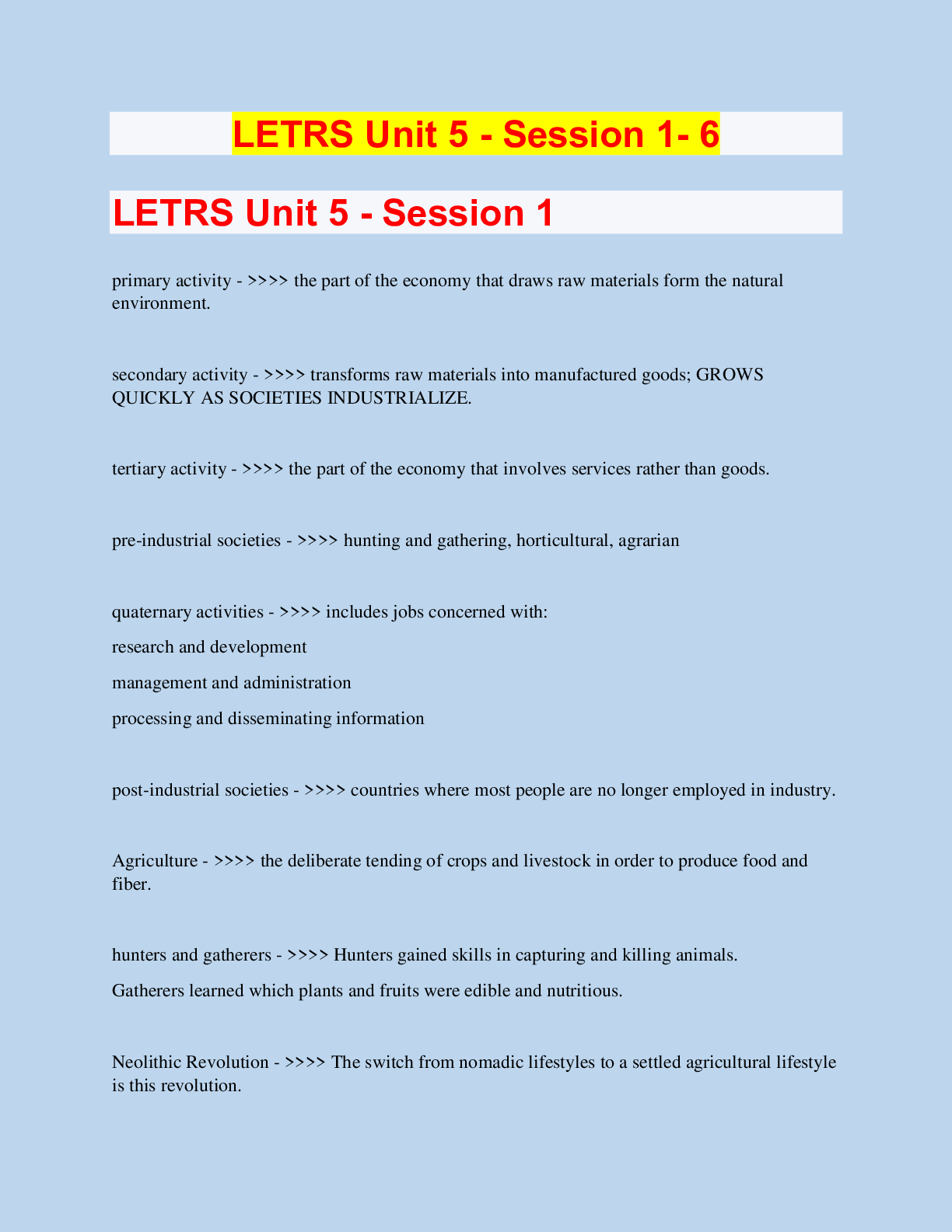Economics > EXAM > GENTECH 3EE3 Quiz Chapter 3 – McMaster University | Chapter 3 Cash Flow Analysis (All)
GENTECH 3EE3 Quiz Chapter 3 – McMaster University | Chapter 3 Cash Flow Analysis
Document Content and Description Below
GENTECH 3EE3 Quiz Chapter 3 – McMaster University Engineering Economics, 5e (Fraser) Chapter 3 Cash Flow Analysis 3.1 Multiple Choice Questions 1) What is an annuity? A) a series of p... ayments that changes by the same proportion from one period to the next B) a series of equal payments over a sequence of equal periods C) a series of payments that changes by a constant amount from one period to the next D) a single payment E) present worth of a series of equal payments Diff: 1 Type: MC Page Ref: 51 Topic: 3.5. Compound interest factors for annuities Skill: Recall User1: Qualitative 2) The present worth factor A) converts an annuity into the equivalent present amount. B) gives the future value equivalent to a series of equal payments. C) converts a series of repeated equal payments into the equivalent future amount. D) gives the present amount that is equivalent to some future amount. E) gives the future amount that is equivalent to a present amount. Diff: 1 Type: MC Page Ref: 49 Topic: 3.4. Compound interest factors for single disbursements and receipts Skill: Recall User1: Qualitative 3) If the growth rate of a series is equal to 5% and annual interest rate is equal to 10%, what is the growth adjusted interest rate? A) +5.00% B) -5.00% C) +4.76% D) -4.76% E) +4.16% Diff: 1 Type: MC Page Ref: 63 Topic: 3.7. Conversion factor for geometric gradient series Skill: Applied User1: Quantitative 4) Five years ago John invested $10 000 at 5% nominal interest rate compounded daily. What is his investment worth today? A) $10 513 B) $11 763 C) $12 763 D) $12 840 E) $13 763 Diff: 2 Type: MC Page Ref: 48 Topic: 3.4. Compound interest factors for single disbursements and receipts Skill: Applied User1: Quantitative 5) An arithmetic gradient series A) starts at zero at the end of the first period and then increases by a constant amount each period. B) starts at zero at the beginning of the first period and then increases by a constant amount each period. C) starts at zero at the end of the second period and then increases by a constant amount each period. D) starts at zero at the beginning of the second period and then increases by a constant amount each period. E) starts at zero at the end of the first period and then increases by an increasing amount each period. Diff: 2 Type: MC Page Ref: 58 Topic: 3.6. Conversion factor for arithmetic gradient series Skill: Recall User1: Qualitative 6) Natalie received a gift of $1 000 from her grandmother. She decides to invest the money into a trip she wants to take when she graduates from college three years from now. What annual rate of return does she have to have to accumulate $1 250 by the time of her graduation? A) 7.7% B) 7.9% C) 8.4% D) 9.2% E) 12.5% Diff: 2 Type: MC Page Ref: 49 Topic: 3.4. Compound interest factors for single disbursements and receipts Skill: Applied User1: Quantitative 7) How much money will you accumulate in a bank account by the end of a 5-year period if you deposit $1 200 today at an interest rate of 2% per year, compounded quarterly? A) $1 230 B) $1 326 C) $1 514 D) $1 783 E) $1 849 Diff: 3 Type: MC Page Ref: 49 Topic: 3.4. Compound interest factors for single disbursements and receipts Skill: Applied User1: Quantitative 8) One standard assumption for annuities and gradients is A) each payment occurs at the beginning of the period. B) annuities and gradients coincide with the beginning of sequential periods. C) annuities and gradients coincide with the end of preceding periods. D) payment period and compounding period differ. E) payment period and compounding period are the same. Answer: E Diff: 2 Type: MC Page Ref: 51, 58, 61 Topic: 3.5. Compound interest factors for annuities Skill: Recall User1: Qualitative 9) The compound amount factor produces A) the present amount, P, that is equivalent to a future amount, F. B) the future amount, F, that is equivalent to a present amount, P. C) the annuity, A, that is equivalent to a future amount, F. D) the annuity, A, that is equivalent to a present amount, P. E) the future amount of arithmetic gradient series. Diff: 1 Type: MC Page Ref: 49 Topic: 3.4. Compound interest factors for single disbursements and receipts Skill: Recall User1: Qualitative 10) If Emily deposits $500 every other year into her bank account that pays 1.5% annual interest, compounded yearly, how much will she accumulate over a 10-year period? A) $2 500 B) $2 568 C) $2 576 D) $2 656 E) $5 738 Diff: 3 Type: MC Page Ref: 51-52 Topic: 3.8. Non-standard annuities and gradients Skill: Applied User1: Quantitative 11) The present worth of an infinitely long uniform series of cash flows is called A) capitalized value. B) salvage value. C) sinking value. D) compound value. E) continuous value. Diff: 2 Type: MC Page Ref: 67 Topic: 3.9. Present worth of infinite annuity Skill: Recall User1: Qualitative 12) When is the growth-adjusted interest rate for a geometric series equal to zero? A) Growth is positive, but less than the interest rate. B) Growth is positive and greater than the interest rate. C) Growth is positive and equal to the interest rate. D) Growth is negative. E) Growth is positive. Diff: 2 Type: MC Page Ref: 63 Topic: 3.7. Conversion factor for geometric gradient series Skill: Recall User1: Quantitative 13) Suppose that you want to evaluate the following non-standard cash flow: $1 000 paid at the end of every third year in a 12-year period with annual interest rate of 10%. What is the best method? A) Convert the non-standard cash flow into standard annuity by changing the interest rate. B) Convert the non-standard cash flow into standard annuity by changing the compounding period. C) Convert the non-standard cash flow into arithmetic gradient series. D) Treat each payment as a separate payment. E) Convert the non-standard cash flow into a geometric gradient series. Diff: 3 Type: MC Page Ref: 65 Topic: 3.8. Non-standard annuities and gradients Skill: Recall User1: Qualitative 14) A municipality has just completed the construction of a bridge. It was calculated that operating and maintenance (O&M) costs of this bridge will be $20 000 in the first year with a 5% increase each year thereafter for the next 4 years. The interest rate used in calculations was 7.5% per year. What interest rate should be used to calculate the present worth of O&M costs over 5 years if we use the geometric series to present worth conversion factor? A) 1.9% B) 2.4% C) 5.0% D) 7.5% E) 8.2% Diff: 2 Type: MC Page Ref: 63 Topic: 3.7. Conversion factor for geometric gradient series Skill: Applied User1: Quantitative 15) Calculating the growth-adjusted interest rate requires: A) the base amount and the rate of growth. B) the base amount and the interest rate. C) the number of periods and the rate of growth. D) the number of periods and the interest rate. E) the rate of growth and the interest rate. Answer: E Diff: 1 Type: MC Page Ref: 63 Topic: 3.7. Conversion factor for geometric gradient series Skill: Recall User1: Qualitative 16) A geometric gradient series A) starts with zero and from period to period increases by a constant amount. B) starts with zero and from period to period increases by a constant rate. C) starts with a certain amount and from period to period increases by a constant amount. D) starts with a certain amount and from period to period increases by a constant rate. E) starts with a certain amount and from period to period decreases by a constant percentage. Diff: 1 Type: MC Page Ref: 61-63 Topic: 3.7. Conversion factor for geometric gradient series Skill: Recall User1: Qualitative 17) Calculate the uniform annuity equivalent to an arithmetic gradient series with a basic payment of $500 per year for 10 years that increases by $50 per year beginning in year 2, under 10% annual interest rate? A) $500 B) $550 C) $686 D) $936 E) $1 186 Diff: 2 Type: MC Page Ref: 60 Topic: 3.6. Conversion factor for arithmetic gradient series Skill: Applied User1: Quantitative 18) How many years will it take for an investment to triple itself if the interest rate is 12% compounded annually? A) 10.0 B) 9.70 C) 9.40 D) 9.10 E) 8.80 Diff: 1 Type: MC Page Ref: 48 Topic: 3.4. Compound interest factors for single disbursements and receipts Skill: Applied User1: Quantitative 19) If i stands for the interest rate, g stands for the growth rate, and io stands for the growth-adjusted interest rate, which of the following is associated with deflation? A) i > g > 0 (io > 0) B) i > g > 0 (io < 0) C) i = g > 0 (io = 0) D) g < 0 (io > 0) E) i = g = 0 Diff: 2 Type: MC Page Ref: 63 Topic: 3.7. Conversion factor for geometric gradient series Skill: Recall User1: Quantitative 20) The present worth of an infinitely long uniform series of cash flows is equal to A) A * [1/i - N/((1 + i)N - 1)] B) A*[(1 + i)N - 1] C) A/(i + 1) D) A * i E) A/i Answer: E Diff: 2 Type: MC Page Ref: 67 Topic: 3.9. Present worth of infinite annuity Skill: Recall User1: Qualitative 21) A company undertakes a 5-year project that requires annual payments. Payment for the first year is $2 000. It will then increase by 5% each subsequent year. The interest is fixed at 5% a year. What is the present worth of this cash flow? A) $9 112 B) $9 328 C) $9 442 D) $9 524 E) $10 226 Diff: 2 Type: MC Page Ref: 63-64 Topic: 3.7. Conversion factor for geometric gradient series Skill: Applied User1: Quantitative 22) How much Jim can accumulate in a private pension fund over 20 years if the fund offers 5% interest compounded annually, and he can afford to deposit $2 000 at the end of every second year? A) $28 946 B) $32 259 C) $66 132 D) $94 256 E) $117 853 Diff: 3 Type: MC Page Ref: 64-65 Topic: 3.8. Non-standard annuities and gradients Skill: Applied User1: Quantitative 23) How much should be set aside each month to accumulate $10 000 at the end of year 3 under 12% annual interest rate compounded monthly? A) $222.14 B) $232.14 C) $242.14 D) $252.14 E) $277.78 Diff: 2 Type: MC Page Ref: 52 Topic: 3.5. Compound interest factors for annuities Skill: Applied User1: Quantitative 24) A person deposits $100 to his savings account biweekly. The savings account pays a nominal interest rate of 5% per year, compounded every six months. What is the effective interest rate for a 6-month period? A) 2.1% B) 2.5% C) 3.2% D) 4.2% E) 5.1% Diff: 2 Type: MC Page Ref: 64 Topic: 3.5. Compound interest factors for annuities Skill: Applied User1: Quantitative 25) A factor that relates a single cash flow in one period to another single cash flow in a later period is A) the uniform series compound amount factor. B) the capital recovery factor. C) the sinking fund factor. D) the annuity conversion factor. E) the compound amount factor. Answer: E Diff: 1 Type: MC Page Ref: 48 Topic: 3.4. Compound interest factors for single disbursements and receipts Skill: Recall User1: Qualitative 26) Capital recovery factor converts A) A into P. B) P into A. C) A into F. D) F into A. E) P into F. Diff: 1 Type: MC Page Ref: 52 Topic: 3.5. Compound interest factors for annuities Skill: Recall User1: Qualitative 27) An annuity due is A) a series that starts at the end of the first period and increases by constant amount thereafter. B) a series that starts at the end of the first period and increases by constant percentage thereafter. C) a series that starts at the end of the first period and remains constant thereafter. D) a series that starts now and increases by constant amount thereafter. E) a series that starts now and remains constant thereafter. Answer: E Diff: 2 Type: MC Page Ref: 54 Topic: 3.5. Compound interest factors for annuities Skill: Recall User1: Qualitative 28) Maria wants to save up for a car. How much should she put in her bank account monthly to save $10 000 in two years if the bank pays 6% interest compounded monthly? A) $293.21 B) $316.67 C) $393.20 D) $401.13 E) $416.67 Diff: 2 Type: MC Page Ref: 51-53 Topic: 3.5. Compound interest factors for annuities Skill: Applied User1: Quantitative 29) Suppose that you have a series of payments: $100 in year 1, $150 in year 2 and $200 in year 3. If annual interest rate is 10%, what is the equivalent annuity for this series? A) $150.00 B) $146.82 C) $142.33 D) $140.11 E) $135.68 Diff: 2 Type: MC Page Ref: 51-53 Topic: 3.6. Conversion factor for arithmetic gradient series Skill: Applied User1: Quantitative 30) Suppose that your salary will increase by 2% per year over the next 4 years. If annual interest rate is also 2% over this period, what is the geometric series to present worth conversion factor in this case? A) 4.08 B) 4.00 C) 3.92 D) 3.56 E) 3.22 Diff: 3 Type: MC Page Ref: 61-64 Topic: 3.7. Conversion factor for geometric gradient series Skill: Applied User1: Quantitative 31) You will need to buy a replacement computer, costing $3 000, in five years time. If you have a bank account which earns 8% annual interest, how much must you put in the bank every year in order to have enough money for the replacement, assuming you make your first deposit in a year's time? A) $565 B) $597 C) $666 D) $675 E) $712 Diff: 3 Type: MC Page Ref: 51-54 Topic: 3.5. Compound interest factors for annuities Skill: Applied User1: Quantitative 32) You want to have a million dollars in the bank when you retire. You think you can save $5 000 a year in a bank that offers you 5% interest. If you make your first deposit in a year's time, how many years will it be from now before you can retire? A) 30 B) 40 C) 50 D) 60 E) 70 Diff: 3 Type: MC Page Ref: 51-54 Topic: 3.5. Compound interest factors for annuities Skill: Applied User1: Quantitative 33) You want to have a million dollars in the bank when you retire. You think you can save $5 000 this year, and increase that by $100 every subsequent year, in a bank that offers you 5% interest. If you make your first deposit in a year's time, how many years will it be from now before you can retire? A) 30 B) 35 C) 40 D) 45 E) 50 Diff: 2 Type: MC Page Ref: 59-60 Topic: 3.6. Conversion factor for arithmetic gradient series Skill: Applied User1: Quantitative 34) You want to have a million dollars in the bank when you retire. You think you can save $5 000 this year, and increase that by 2% every subsequent year, in a bank that offers you 5% interest. If you make your first deposit in a year's time, how many years will it be from now before you can retire? A) 41 B) 42 C) 43 D) 44 E) 45 Diff: 2 Type: MC Page Ref: 61-64 Topic: 3.7. Conversion factor for geometric gradient series Skill: Applied User1: Quantitative 35) Every leap year you get a bonus of $20 000, which you put into a retirement account at 5% interest. If your first payment into the account is made in four years time, and you put no other money into the account, how long will it be before you can retire with a million dollars? A) 36 B) 40 C) 44 D) 48 E) 52 Answer: E Diff: 2 Type: MC Page Ref: 65 Topic: 3.8. Non-standard annuities and gradients Skill: Applied User1: Quantitative 36) You are offered a series of monthly payments of $10, continuing forever. If you deposit these at a nominal interest rate of 12%, compounded monthly, what is the present worth of the series? A) $120 B) $1000 C) $1200 D) $1500 E) Infinite Diff: 2 Type: MC Page Ref: 67 Topic: 3.9. Present worth of infinite annuity Skill: Applied User1: Quantitative 37) You are promised that when you retire from your current job, in 40 years time, you will receive a gold watch valued at $1 000. If you can invest money at 5% annual interest, what is the present worth of this promise? A) $142 B) $156 C) $167 D) $211 E) $231 Diff: 2 Type: MC Page Ref: 48-49 Topic: 3.4. Compound interest factors for single disbursements and receipts Skill: Applied User1: Quantitative 3.2 Short Answers 1) A wholesale company has decided to build a new warehouse 3 years from now. It must accumulate $600 000 by the end of the 3-year period by putting aside an equal amount from its revenue at the end of each year. If the annual interest rate is 9%, how much the company should put aside each year? Answer: The problem requires calculation of the annuity given the future worth of the entire cash-flow. The solution is obtained via the sinking factor: A = $600 000 x (A/F, 9%, 3) = $600 000 x 0.30505 = $183 032.85 Diff: 1 Type: SA Page Ref: 51 Topic: 3.5. Compound interest factors for annuities Skill: Applied User1: Quantitative 2) A trucking firm purchased two B-train trucks for $325 000. It paid 20% as a down payment and obtained a bank loan for the rest. The loan has a nominal interest rate of 10.5% compounded monthly with a 10-year amortization period. The loan term is 10 years. What are the firm's monthly payments to the bank? own-payment is $65 000 (20% of $325 000). Subtract down-payment from the total truck costs to get the amount that should be borrowed from a bank: $325 000 - $65 000 = $260 000. The amortization period is the duration over which the bank loan should be paid back to the bank. Therefore: A = $260 000 x (A/P, 10.5/12%, [10 x 12]) = $3 508.31. Diff: 3 Type: SA Page Ref: 52 Topic: 3.5. Compound interest factors for annuities Skill: Applied User1: Quantitative 3) An oil-extracting company expects to produce 1 000 barrels of oil a day over the next 5 years. If the oil price remains at $80 per barrel for the duration of the project, what will be the company's accumulated total revenue at the end of the fifth year under 5% annual interest rate? Answer: Annual production = 1 000 barrels/day x 365 days = 365 000 barrels/year Annual revenue = $80/barrel x 365 000 barrels/year = $29 200 000/year = 29.2 million/year FW(Annual Revenue) = $29.2 x (F/A, 5%, 5) = $161.348 million Diff: 2 Type: SA Page Ref: 52 Topic: 3.5. Compound interest factors for annuities Skill: Applied User1: Quantitative 4) John wants to buy a laptop computer in one year. He is working part time earning $600 per month. The computer John wants to buy costs $2 000. He decides to invest money in securities that pay a monthly rate of 2%. How much should John put aside every month to accumulate the required amount? Answer: The following equation reflects the problem: 2 000 = A(F/A, 2%, 12) ; hence A = $149.12/month. Diff: 1 Type: SA Page Ref: 52 Topic: 3.5. Compound interest factors for annuities Skill: Applied User1: Quantitative 5) You want to buy a car that costs $20 000. You have to pay $2 000 upfront as a down-payment, and you are considering a financing option with a bank. If the bank charges 1.9% annual interest rate compounded daily, what would be your monthly payment for the 48-month financing period? Answer: The effective monthly interest rate is ie = (1+0.019/365)30 - 1 = 0.0015628 or 0.15628% per month. The amount you want to finance is $18 000. Therefore, your monthly payment A is given by A(P/A, 0.15628%, 48) = 18 000. Hence A = $389.53. Diff: 3 Type: SA Page Ref: 51-58 Topic: 3.5. Compound interest factors for annuities Skill: Applied User1: Quantitative 6) Stan saved $1 000 working part-time at a store. He wants to use this money for a trip to Europe. He is a smart guy and therefore decides to invest the money into an investment fund with a 24% annual interest rate compounded monthly. The trip to Europe costs $2 500. How long (in months) should Stan keep his money in the investment fund to accumulate the required amount? Answer: The problem can be represented by the equation: $1 000 x (F/P, ie, N) = $2 500 where ie is the monthly rate of return and N is the number of months. The effective monthly rate of return is 24%/12 = 2% and therefore, the equation for N becomes 1 000 x (1 + 0.02)N = $2 500. N = 46.3 month is the solution. Diff: 2 Type: SA Page Ref: 51-58 Topic: 3.4. Compound interest factors for single disbursements and receipts Skill: Applied User1: Quantitative 7) A manufacturing company expects a steady 2% annual growth in profits over the next three years. The company wants to invest the profits at a 10% interest rate. Expected annual profit of the company in year one is $1 000. How much will be accumulated by the company by the end of the third year? Answer: The growth adjusted interest rate can be calculated as i = (1 + 0.1) x (1+0.02) - 1 = 0.122 or 12.2%. Therefore, the accumulated amount is: 1 000 x (F/A, 12.2%, 3) = 1 000 x 3.38088 = $3 380.88. Diff: 1 Type: SA Page Ref: 61-64 Topic: 3.7. Conversion factor for geometric gradient series Skill: Applied User1: Quantitative 8) The maintenance costs of a car are approximately $400 per year. With age the costs increase by $100 a year. What is the future worth of the maintenance costs in five years' time if the interest rate is 5% compounded annually? Answer: The maintenance costs are an arithmetic gradient series. The arithmetic gradient to annuity conversion factor is (A/G, 5%, 5) = 1/0.05 - 5/[(1+0.05)5 - 1]. This means that the geometrically-increasing annuity of $400 per year is equivalent to a uniform annuity of $400 + $100 x 1.90252 = $590.25 per year over the five-year period. So the future worth of the maintenance costs is $590.25 x (F/A, 5%,5) = $3 261.5. Diff: 2 Type: SA Page Ref: 58-61 Topic: 3.6. Conversion factor for arithmetic gradient series Skill: Applied User1: Quantitative 9) Suppose you are evaluating a project that has various annual payments. These payments do not fall into any of the standard categories you have learned before. How would you approach this project? Answer: There are three ways to deal with the problem: (i) convert non-standard annuities or gradients into standard by changing the compounding period; (ii) convert non-standard annuities or gradients into standard by re-defining them over the existing compounding period, (iii) if (i) and (ii) cannot be used, treat each payment as a single payment. Diff: 2 Type: SA Page Ref: 65 Topic: 3.8. Non-standard annuities and gradients Skill: Recall User1: Qualitative 10) The Croesus Trust Fund currently has $1 million. It was established 10 years ago. The rate of return on the Fund's money has been 5% compounded daily. How much money was originally invested into the Fund? Answer: We are given future worth, and we need to find its present worth. However, we have to find the effective annual interest rate first. It is (1 + 0.05/365)365 - 1 = 0.05127 or 5.127%. Now we can use the present worth factor: $1 000 000 * (P/F, 5.127%, 10) = $606 552 Diff: 2 Type: SA Page Ref: 49 Topic: 3.4. Compound interest factors for single disbursements and receipts Skill: Applied User1: Quantitative 11) Explain why the growth-adjusted interest rate in the geometric gradient series to present worth conversion factor is less than the original interest rate when the growth factor is positive. Answer: The interest rate reduces the present value of future cash flows. If the growth factor is positive, this reduction is offset by the increase in the value of each cash flow. Diff: 2 Type: SA Page Ref: 64 Topic: 3.7. Conversion factor for geometric gradient series Skill: Recall User1: Qualitative 12) If the growth adjusted interest rate is negative, how should we proceed with calculation of the present worth of a geometric gradient series? Answer: In such a case, we can still use the original formula for the geometric gradient series to present worth conversion factor. Diff: 2 Type: SA Page Ref: 63 Topic: 3.7. Conversion factor for geometric gradient series Skill: Recall User1: Qualitative 13) It is known that a bridge costs $10 million to build, and it will be in operation forever. In order to recover initial investment, what should the annual revenue be in this case under 10% interest rate? Answer: $10 million is the capitalized value of a series, and therefore, the required annual revenue can be defined as $10 000 000 ∗ 0.01 = $100 000/year. Diff: 2 Type: SA Page Ref: 67 Topic: 3.9. Present worth of infinite annuity Skill: Applied User1: Quantitative 14) It is expected that a company is going to invest $8 million in a project. It is also expected that the annual revenue from this project will be $2 million dollars. How long would it take for the company to recover its investment under a 20% interest rate? Under 10%? Answer: It is possible to set up the following equation: 8 = 2 ∗ [[(1 + i)x - 1]/[i ∗ (1 + i)x]] and solve it for x under 20% and 10% interest rate. Alternatively, we can set up a spreadsheet calculating the present worth of the annuity under each interest rate. Under 20% interest rate, it takes 8 years and 10 months to recover the investment. However, under 10% interest rate it takes only 5 years and 5 months to recover the investment. Therefore, with an increase in the interest rate the recovery period increases. Diff: 2 Type: SA Page Ref: 51-58 Topic: 3.5. Compound interest factors for annuities Skill: Applied User1: Quantitative 15) Amy got $5 000 from her grandma to pay her tuition fee. She invested this amount at a 10% rate of return in an investment fund and simultaneously took a student loan for the same amount at a 6% interest rate compounded daily. Was it a smart move? t the end of the first year, $5 000 in the investment fund becomes 5 000 ∗ (1 + 0.1) = $5 500. The accumulated debt of the student loan can be calculated using the effective annual interest rate ie: ie = (1 + 0.06/365)365 = 0.06183 or 6.183%. Therefore, the accumulated debt will be 5 000 ∗ (1 + 0.06183) = $5 309.15. Since the amount in the investment fund exceeds the accumulated debt, Amy made a smart move. Diff: 2 Type: SA Page Ref: 48 Topic: 3.4. Compound interest factors for single disbursements and receipts Skill: Applied User1: Quantitative 16) In this question, you are to write down the conversion factors that are required to transform the solid arrows into the equivalent dotted arrow. You can either indicate your answer by marking labelled arrows on the diagram, or by writing down a formula, as in the example given below: Answer: P = F1(F/P,i,1) + F2(P/F,i,1) Diff: 1 Type: SA Page Ref: 48-49 Topic: 3.4. Compound interest factors for single disbursements and receipts Skill: Applied User1: Quantitative 17) In this question, you are to write down the conversion factors that are required to transform the solid arrows into the equivalent dotted arrow. You can either indicate your answer by marking labelled arrows on the diagram, or by writing down a formula, as in the example given below: Answer: P=A(P/A,i, 4) Diff: 1 Type: SA Page Ref: 51-53 Topic: 3.5. Compound interest factors for annuities Skill: Applied User1: Quantitative 18) In this question, you are to write down the conversion factors that are required to transform the solid arrows into the equivalent dotted arrow. You can either indicate your answer by marking labelled arrows on the diagram, or by writing down a formula, as in the example given below: Answer: P=A(F/A,i,4)(F/P,i,1) or P=A(P/A,i,4)(F/P,i,5) Diff: 2 Type: SA Page Ref: 51-53 Topic: 3.5. Compound interest factors for annuities Skill: Applied User1: Quantitative 19) In this question, you are to write down the conversion factors that are required to transform the solid arrows into the equivalent dotted arrow. You can either indicate your answer by marking labelled arrows on the diagram, or by writing down a formula, as in the example given below: Answer: P=(B+A(P/A,i,4))(F/P,i,5)-53 Diff: 2 Type: SA Page Ref: 48 Topic: 3.5. Compound interest factors for annuities Skill: Applied User1: Quantitative 20) In this question, you are to write down the conversion factors that are required to transform the solid arrows into the equivalent dotted arrow. You can either indicate your answer by marking labelled arrows on the diagram, or by writing down a formula, as in the example given below: Answer: P = A((F/P,i,1)+(F/P,i,3)+(F/P,i,5)) (Treating each cashflow separately) or P = A(A/F,i,2)(F/A,i,6)(F/P,i,1) (Converting each cashflow to an annual annuity over two years) Diff: 3 Type: SA Page Ref: 65-66 Topic: 3.8. Non-standard annuities and gradients Skill: Applied User1: Quantitative 21) In this question, you are to write down the conversion factors that are required to transform the solid arrows into the equivalent dotted arrow. You can either indicate your answer by marking labelled arrows on the diagram, or by writing down a formula, as in the example given below: =P(A/P,i,5) Diff: 1 Type: SA Page Ref: 51-53 Topic: 3.5. Compound interest factors for annuities Skill: Applied User1: Quantitative 22) In this question, you are to write down the conversion factors that are required to transform the solid arrows into the equivalent dotted arrow. You can either indicate your answer by marking labelled arrows on the diagram, or by writing down a formula, as in the example given below: =P(F/P,i,1)(A/P,i,5) Diff: 2 Type: SA Page Ref: 48-53 Topic: 3.5. Compound interest factors for annuities Skill: Applied User1: Quantitative 23) In this question, you are to write down the conversion factors that are required to transform the solid arrows into the equivalent dotted arrow. You can either indicate your answer by marking labelled arrows on the diagram, or by writing down a formula, as in the example given below: =G(A/G,i,6) Diff: 2 Type: SA Page Ref: 58-61 Topic: 3.6. Conversion factor for arithmetic gradient series Skill: Applied User1: Quantitative 24) In this question, you are to write down the conversion factors that are required to transform the solid arrows into the equivalent dotted arrow. You can either indicate your answer by marking labelled arrows on the diagram, or by writing down a formula, as in the example given below: Answer: P=G(A/G,i,6)(P/A,i,6) (We convert the arithmetic series to a uniform annuity, then find the present worth of the uniform annuity.) Diff: 2 Type: SA Page Ref: 58-61 Topic: 3.6. Conversion factor for arithmetic gradient series Skill: Applied User1: Quantitative 25) In this question, you are to write down the conversion factors that are required to transform the solid arrows into the equivalent dotted arrow. You can either indicate your answer by marking labelled arrows on the diagram, or by writing down a formula, as in the example given below: Answer: P=G(A/G,i,6)(F/A,i,6)(F/P,i,1) (We convert the arithmetic progression to a uniform annuity, find the future worth of that annuity, then move the result one year further into the future.) Diff: 2 Type: SA Page Ref: 59-61 Topic: 3.6. Conversion factor for arithmetic gradient series Skill: Applied User1: Quantitative 26) In this question, you are to write down the conversion factors that are required to transform the solid arrows into the equivalent dotted arrow. You can either indicate your answer by marking labelled arrows on the diagram, or by writing down a formula, as in the example given below: Answer: P=(A+G(A/G,i,6))(P/A,i,6) We convert the arithmetic series to an annuity, add this to the existing annuity, then find the annual worth of the sum of the annuities. Diff: 2 Type: SA Page Ref: 59-61 Topic: 3.6. Conversion factor for arithmetic gradient series Skill: Applied User1: Quantitative 27) In this question, you are to write down the conversion factors that are required to transform the solid arrows into the equivalent dotted arrow. You can either indicate your answer by marking labelled arrows on the diagram, or by writing down a formula, as in the example given below: Answer: P = (A+G(A/G,i,6))(P/A,i,6) - F(P/F,i,7) Diff: 2 Type: SA Page Ref: 59-61 Topic: 3.6. Conversion factor for arithmetic gradient series Skill: Applied User1: Quantitative [Show More]
Last updated: 1 year ago
Preview 1 out of 52 pages
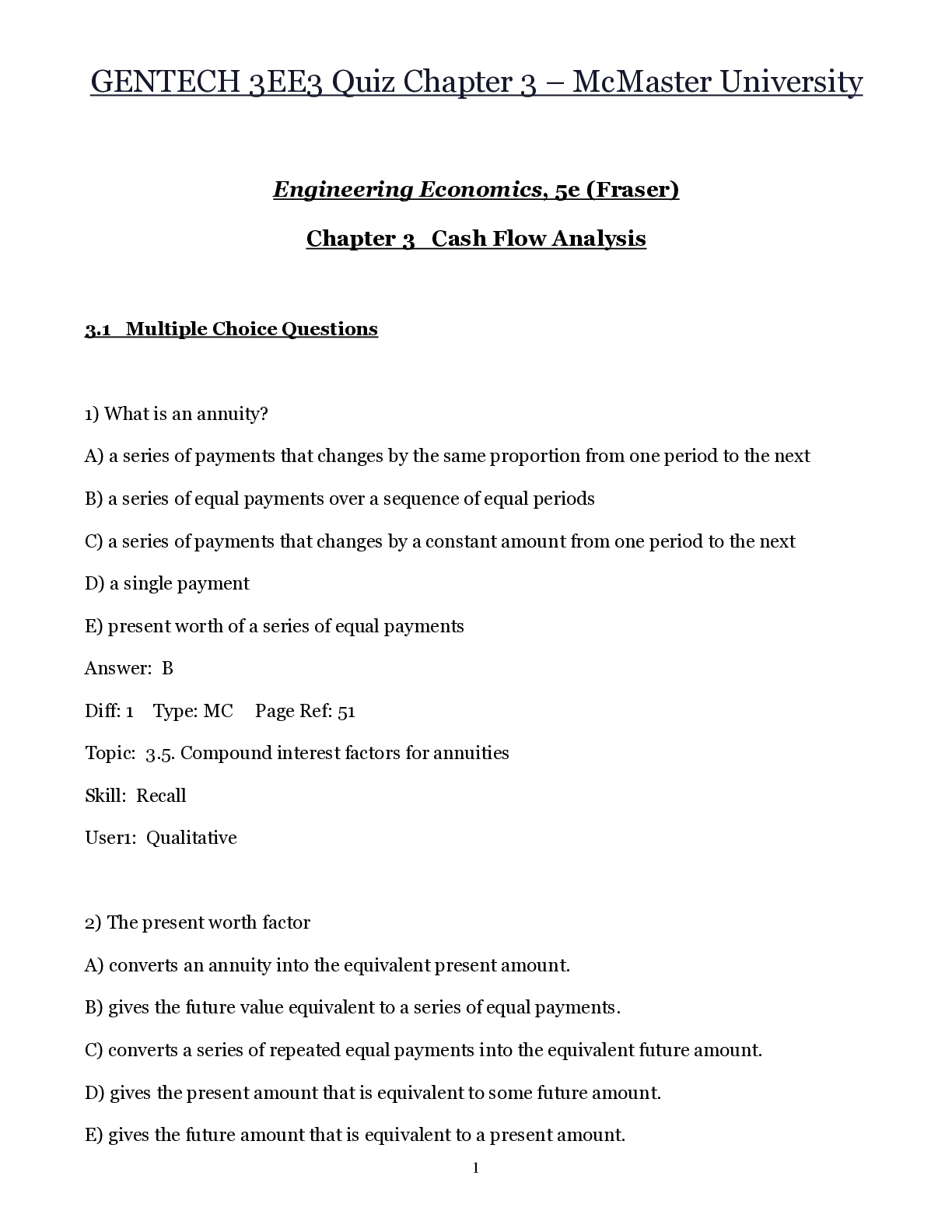
Reviews( 0 )
Document information
Connected school, study & course
About the document
Uploaded On
Nov 08, 2020
Number of pages
52
Written in
Additional information
This document has been written for:
Uploaded
Nov 08, 2020
Downloads
0
Views
88

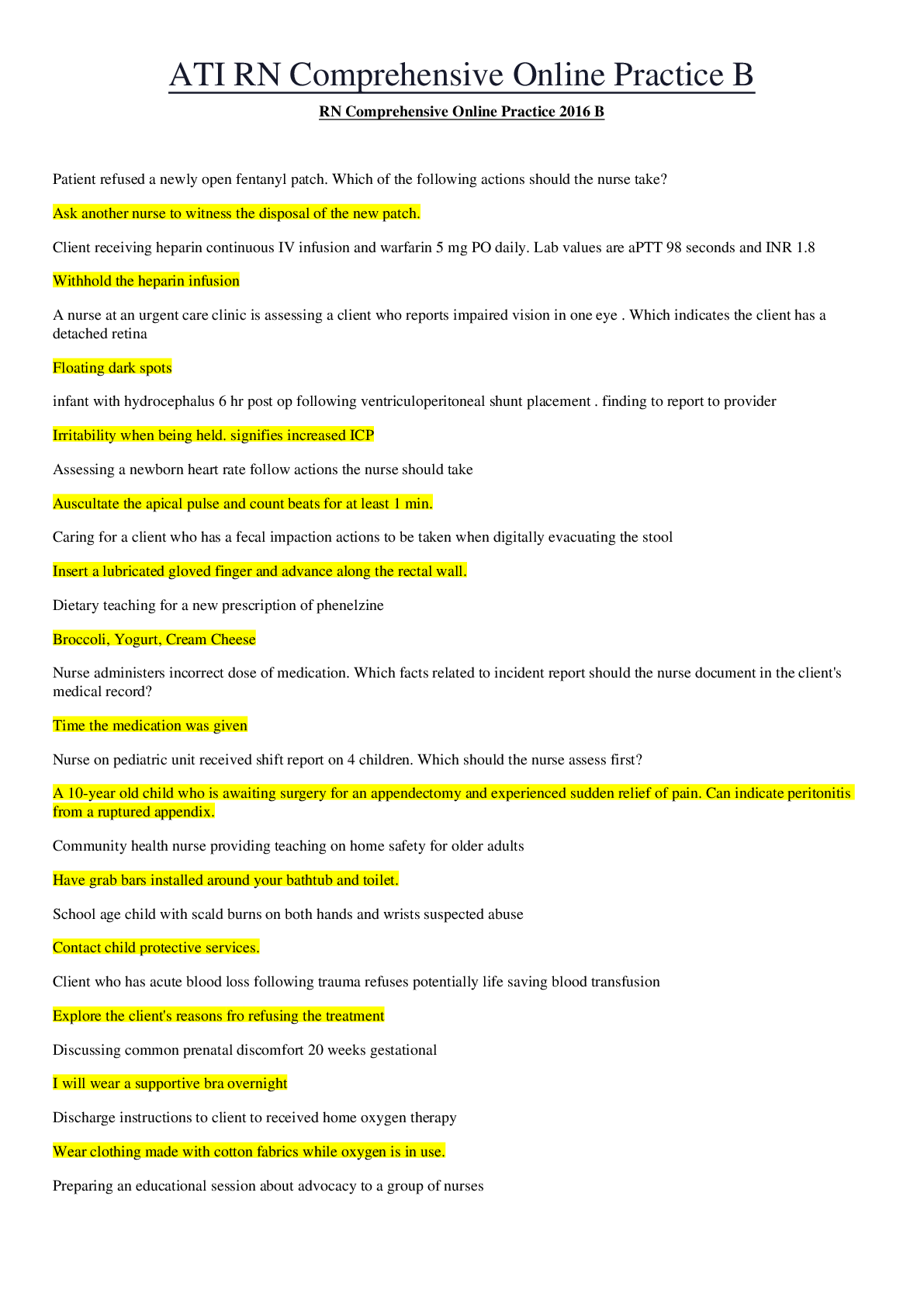


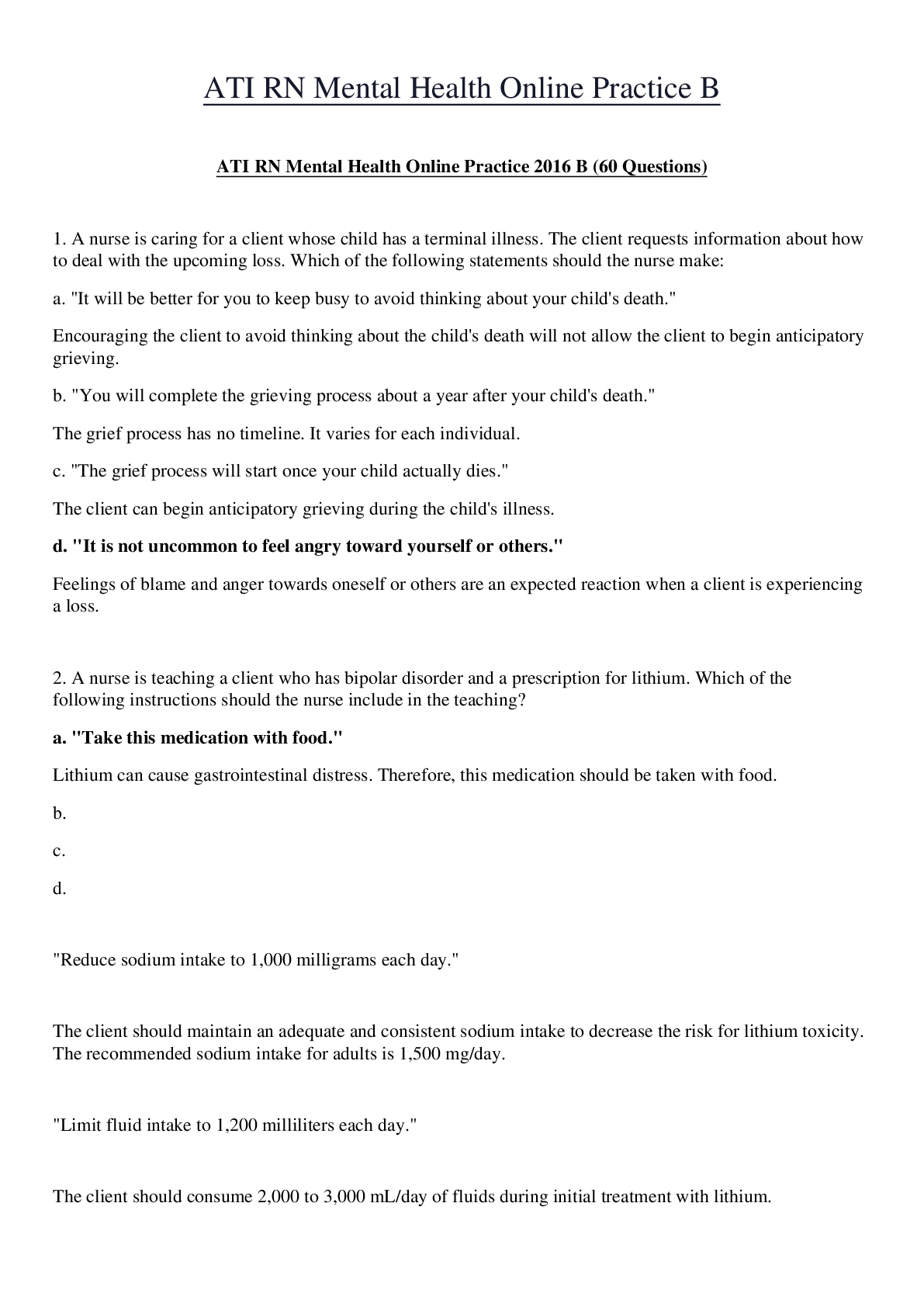

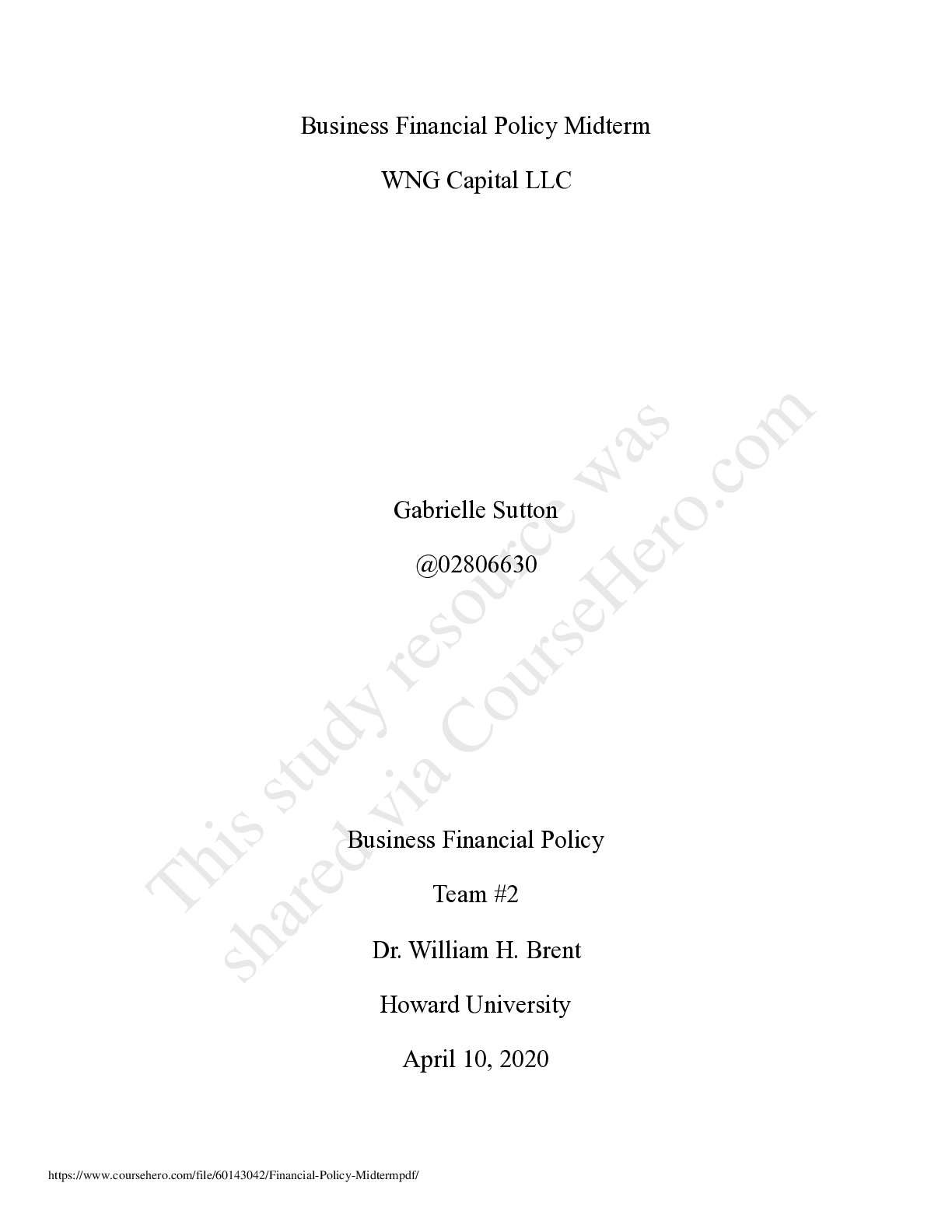
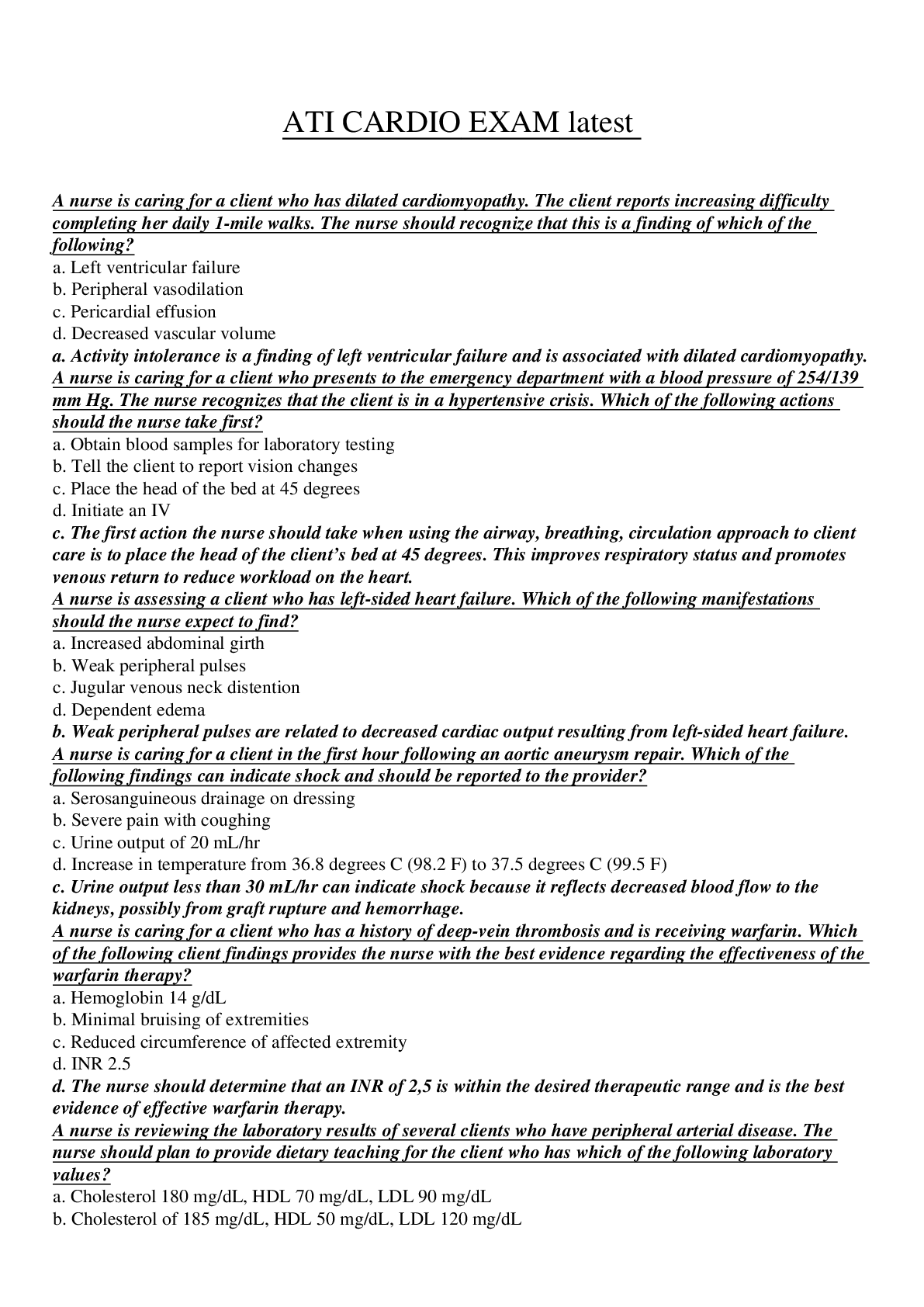
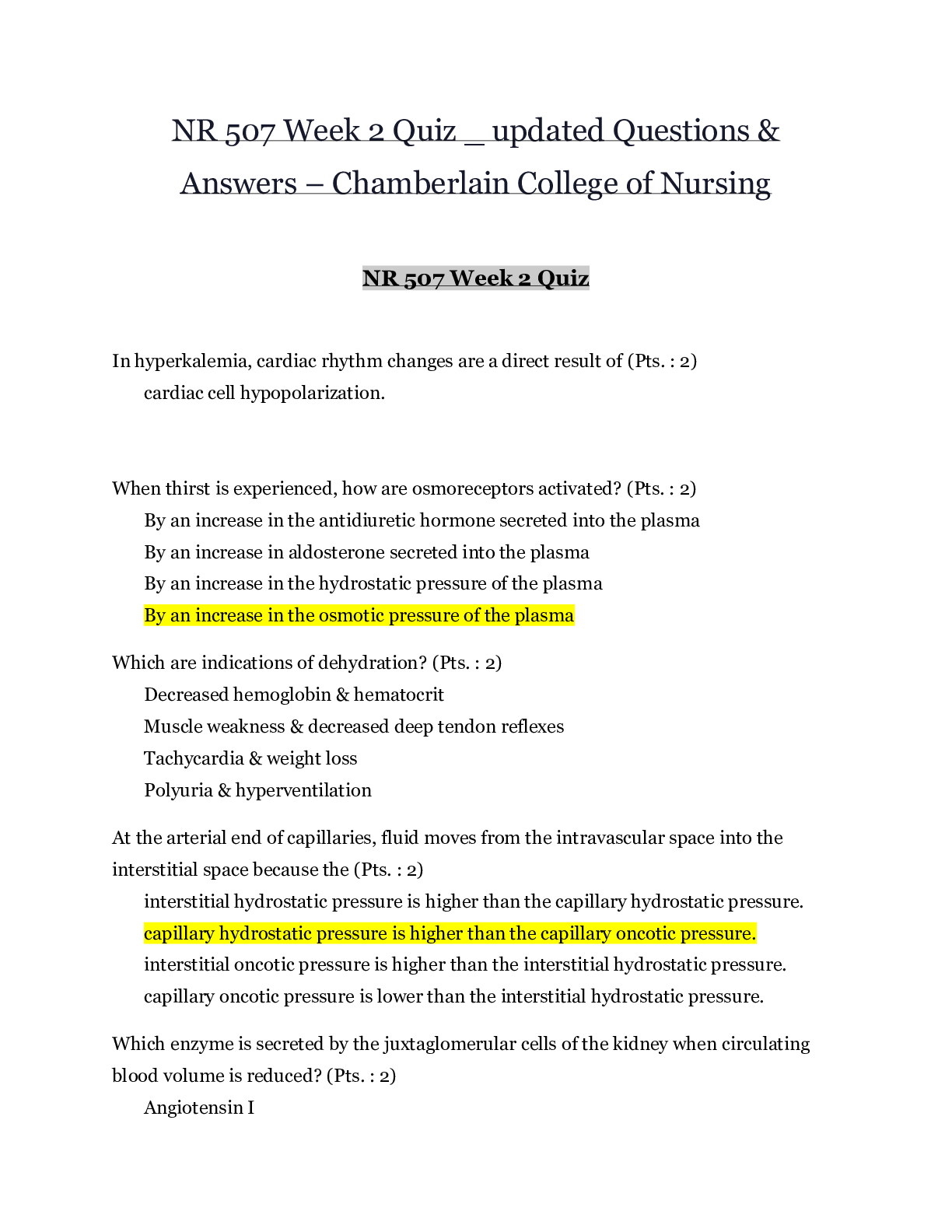
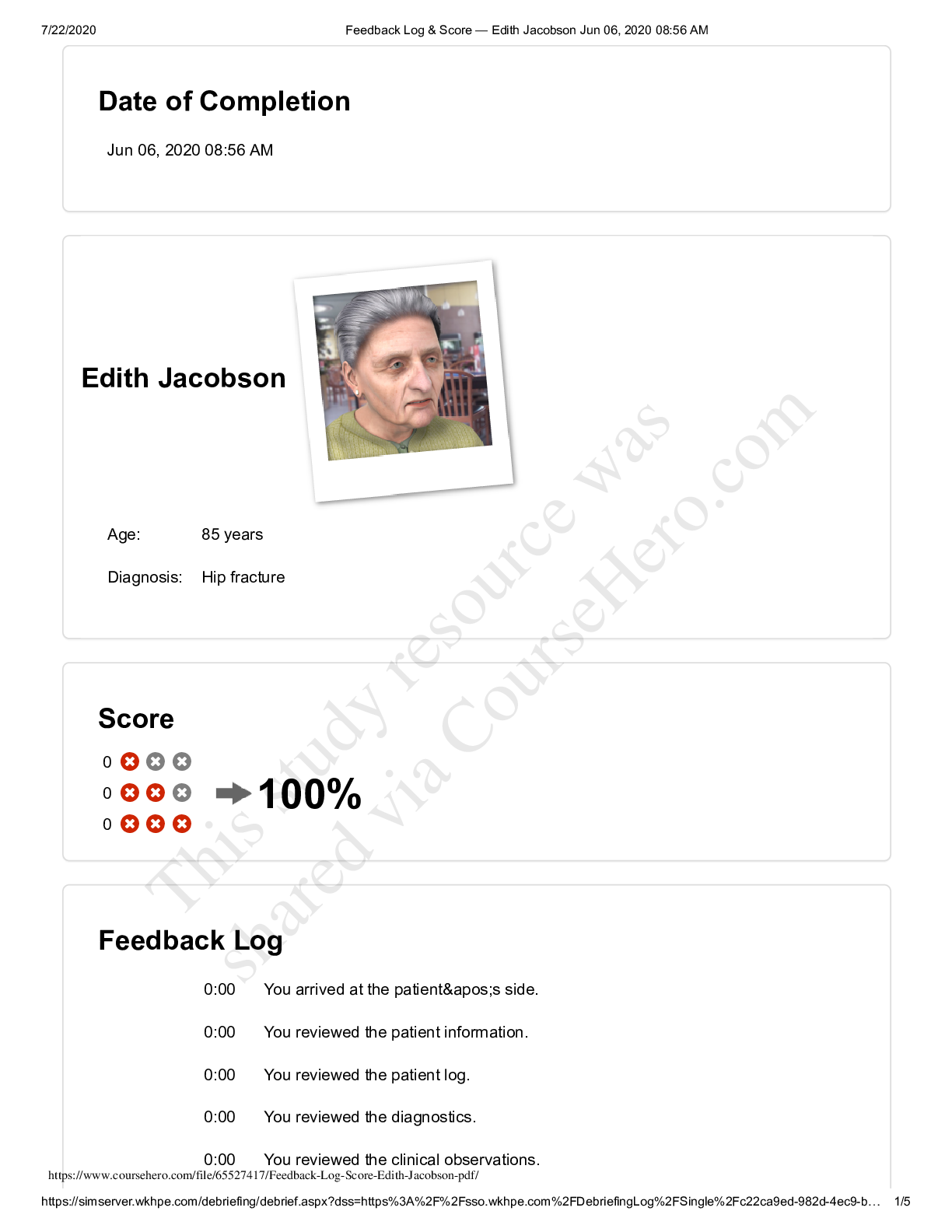
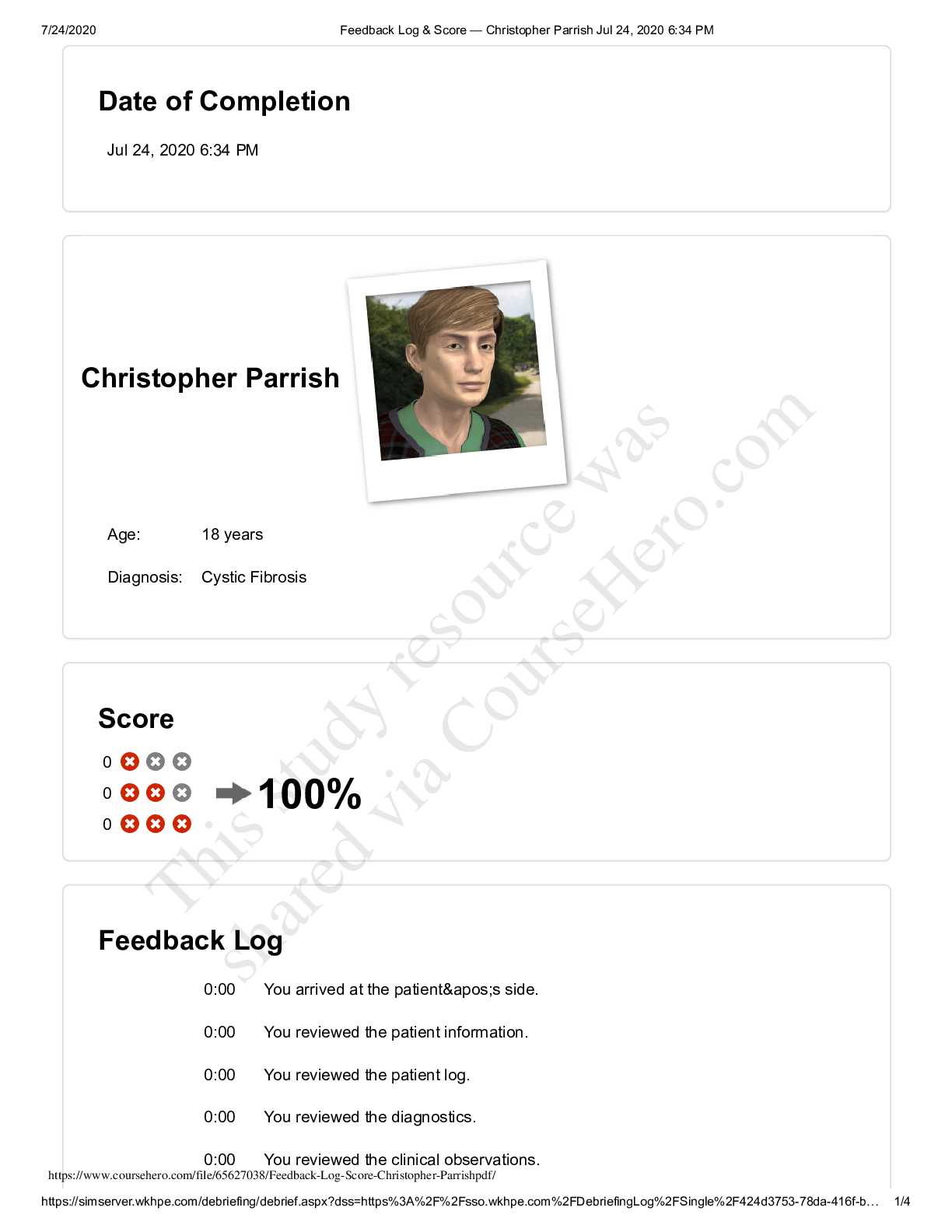
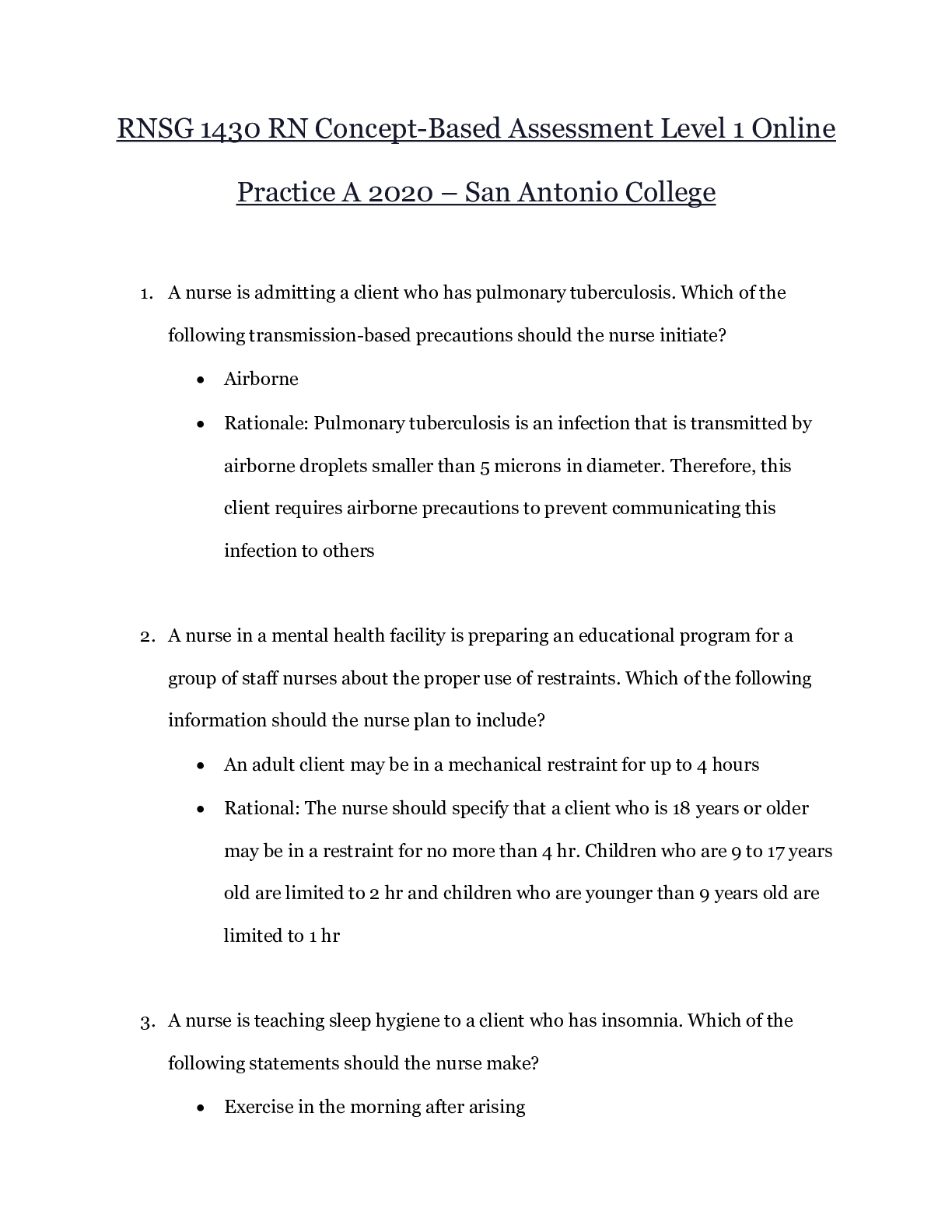


 – CHAMBERLAIN COLLEGE OF NURSING.png)
